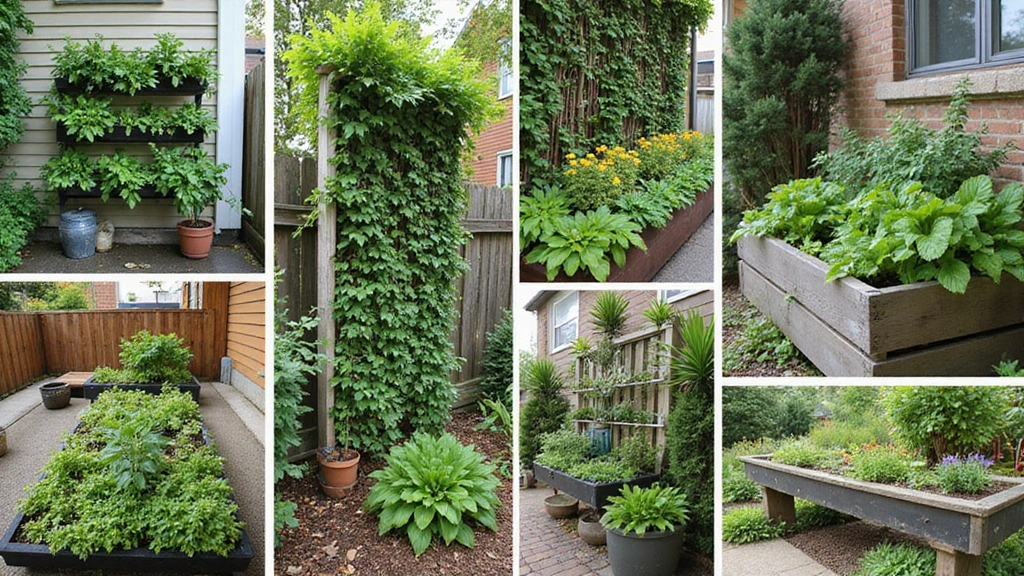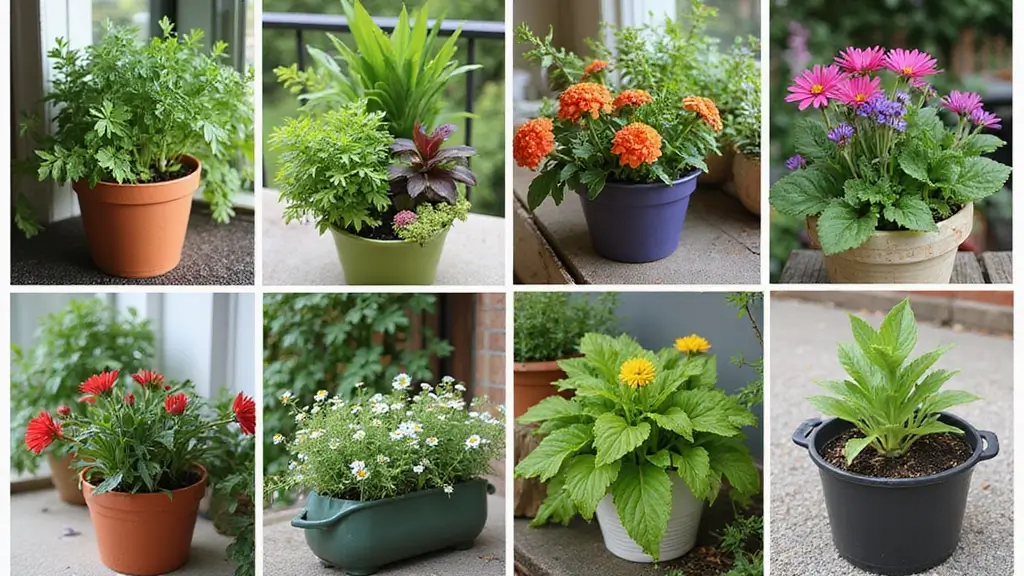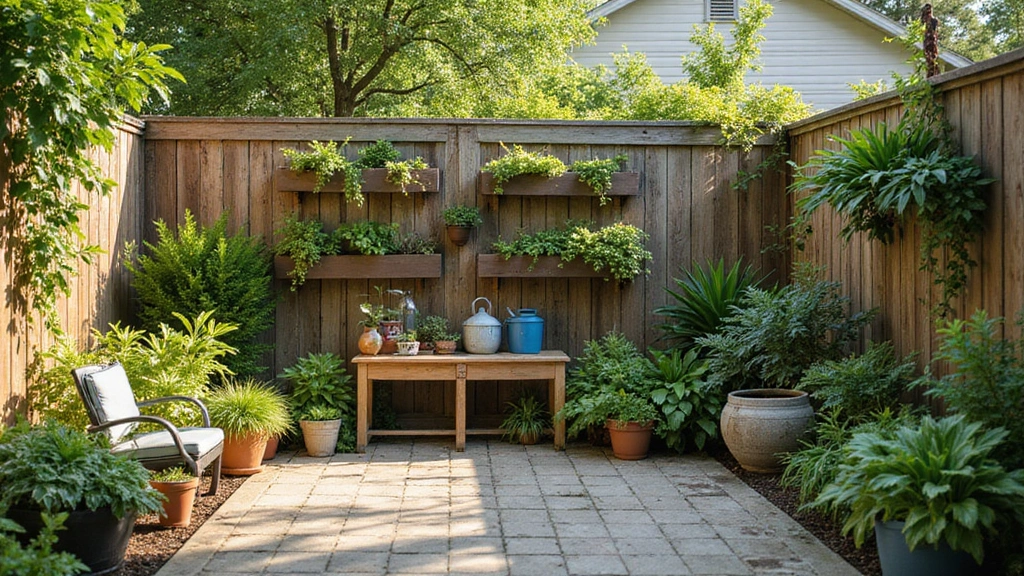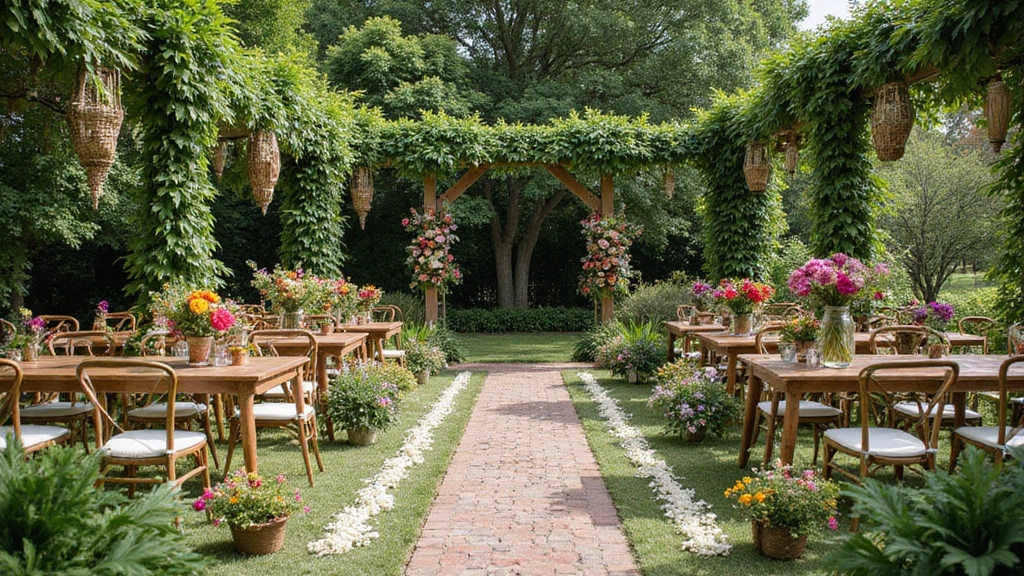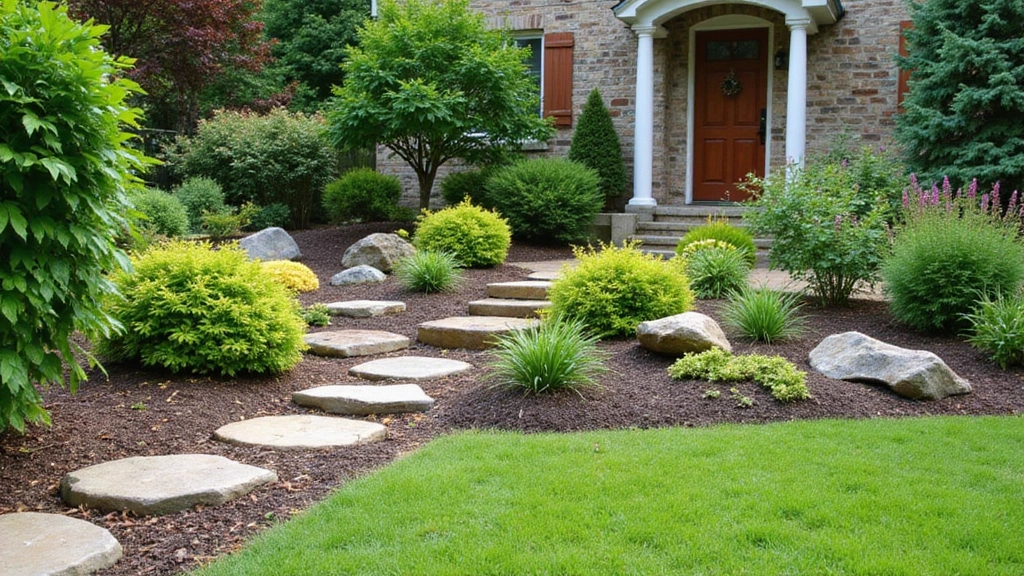Creating a garden in limited space can feel daunting, but with clever designs and innovative ideas, anyone can cultivate a flourishing green sanctuary.
From vertical gardens to container layouts, each plan offers unique benefits tailored to fit urban settings and small outdoor areas. Whether you’re looking to grow fresh vegetables or simple flowers, the possibilities are endless! Let’s take a journey through 30 amazing grow-a-garden layout plans that cater to small spaces and urban homes, revealing how you can make the most of every inch.
Get ready to roll up your sleeves and dig into these inspiring garden design ideas!
1. Vertical Wall Garden
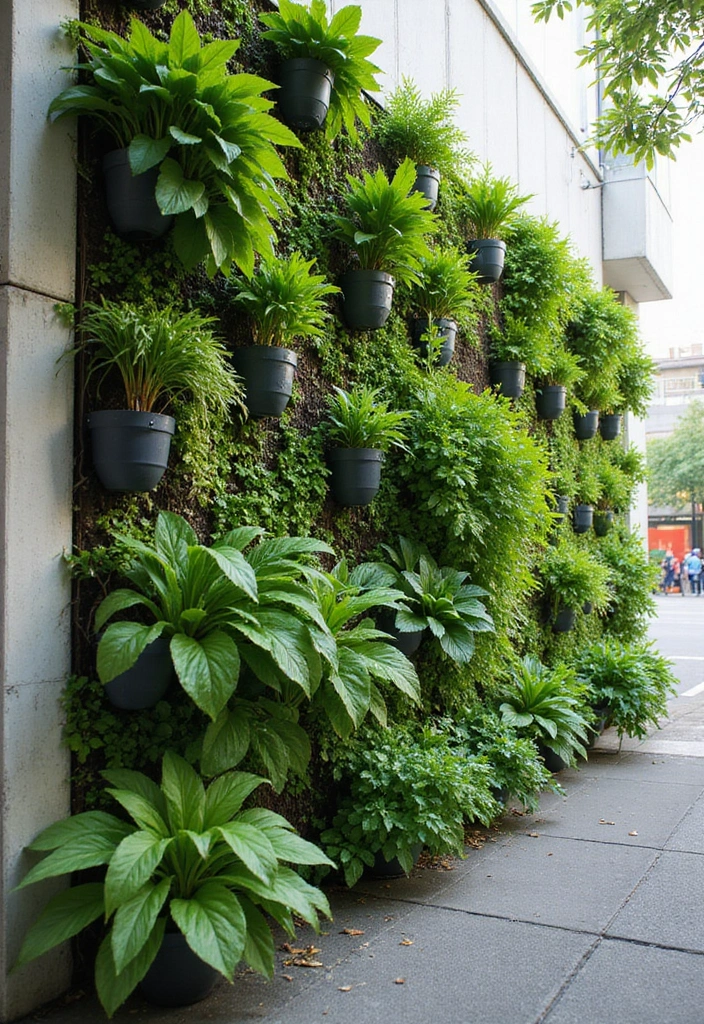
Transform a plain wall into a stunning vertical garden that not only saves space but also creates an attractive focal point. For this, consider using the Worth Garden upgraded 12 sets (36-pocket) self watering stackable vertical planters. This modular vertical planter system is perfect for hanging herbs and small flowers, allowing urban dwellers with limited ground space to enjoy gardening.
When setting up your vertical garden, choose lightweight planters with good drainage to prevent any wall damage. The planters from Worth Garden are designed specifically for this purpose, ensuring your wall stays intact while maximizing your planting potential. Additionally, select plants that thrive in vertical spaces, such as succulents, ferns, and herbs.
To make watering a breeze, consider incorporating a Rain Bird drip irrigation kit for container gardens. This kit will help you maintain the right moisture levels without the hassle of frequent watering.
For a more affordable option, the iPower 2-pack hanging vertical wall planter is a great choice. With its seven pockets, it provides ample space for growing herbs and flowers, making it ideal for smaller areas like balconies or fences.
As you set up your vertical garden, remember to regularly rotate the plants for even light exposure. This layout not only maximizes space but also adds a lush touch to your environment, turning a simple wall into a vibrant green oasis.
2. Ladder Planter
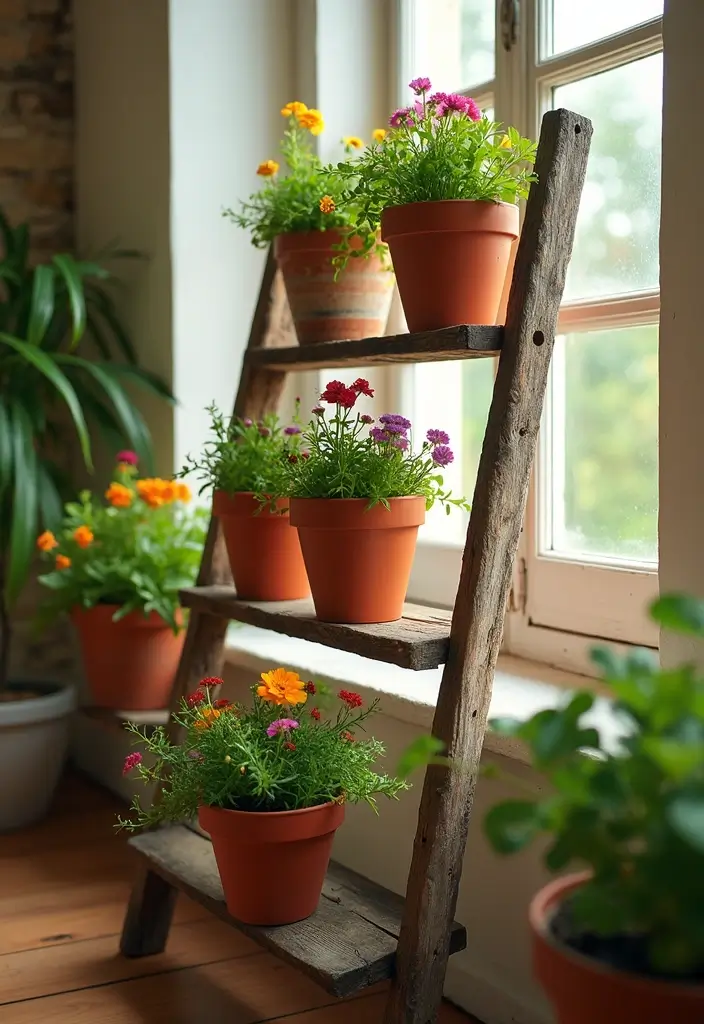
A ladder planter is a creative way to utilize vertical space while adding a rustic charm to your patio or balcony. You can easily upcycle an old wooden ladder by placing containers on each rung, creating an array of plants at different heights for a visually interesting display. Here’s how to make it work:
– Secure the ladder against a wall to prevent it from tipping over.
– Choose lightweight plant pots that are fitting for the ladder’s structure. These 7 to 4.8-inch pots are perfect for various plants and will help keep your ladder stable and easy to manage.
– Use trailing plants like sweet potato vine starter plants for an added cascading effect. Their beautiful drape will enhance the visual appeal of your ladder planter.
– Position it where it receives adequate sunlight for your chosen plants, and consider adding a vertical garden planter as well. This planter can be a great complement, providing additional space for herbs, flowers, or vegetables.
With a little creativity and the right products, a ladder planter can become a stunning centerpiece in your garden or outdoor space.
3. Hanging Baskets
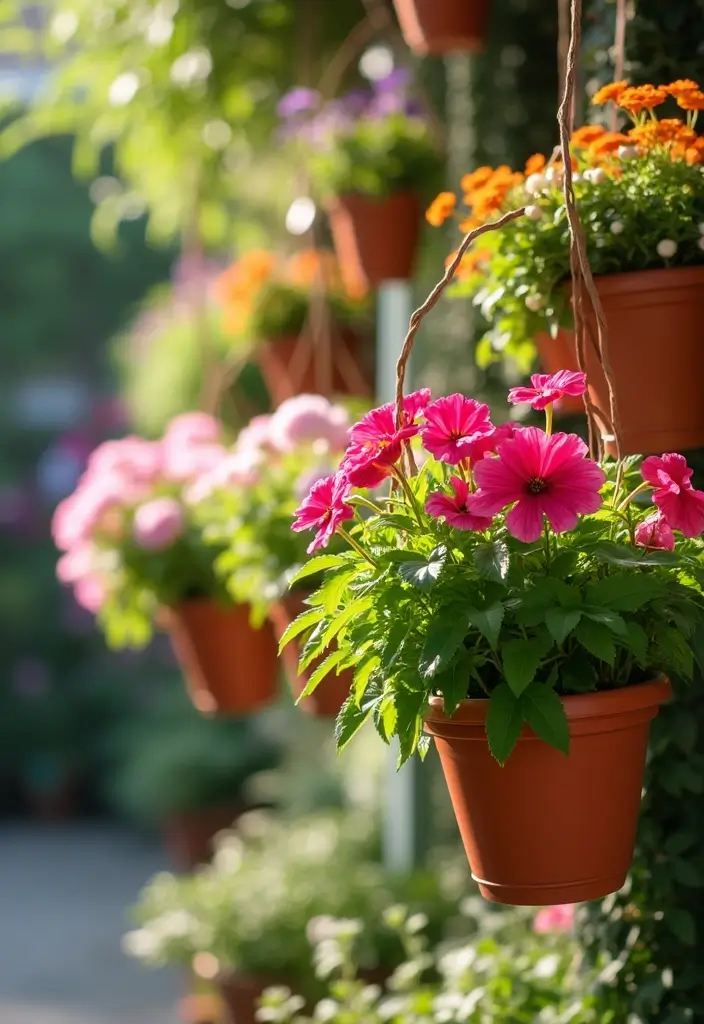
Hanging baskets are a classic solution for small spaces, giving you the freedom to garden in the air instead of on the ground. You can fill them with trailing flowers, herbs, or even strawberries. The beauty of this layout is that it adds depth to your garden without taking up precious floor space.
To get started, consider using a mix of annuals and perennials for continuous blooms throughout the season. For your baskets, you might want to check out the hanging planter baskets, which feature metal construction and a coco liner that helps retain moisture while allowing for proper drainage.
Keep in mind that hanging baskets tend to dry out faster, so it’s essential to monitor their watering needs. A great option here is the self-watering hanging baskets. These pots come with a visual reservoir and drainage holes, making it easier to ensure your plants stay hydrated without constant attention.
Also, consider using a lightweight potting mix like the lightweight garden potting mix from Burpee. It’s perfect for container gardening, whether you’re growing vegetables, flowers, or herbs, and will help your plants thrive in their hanging arrangements.
Lastly, experiment with different heights for a layered effect, bringing color and life to any small garden area you have.
4. Container Vegetable Garden
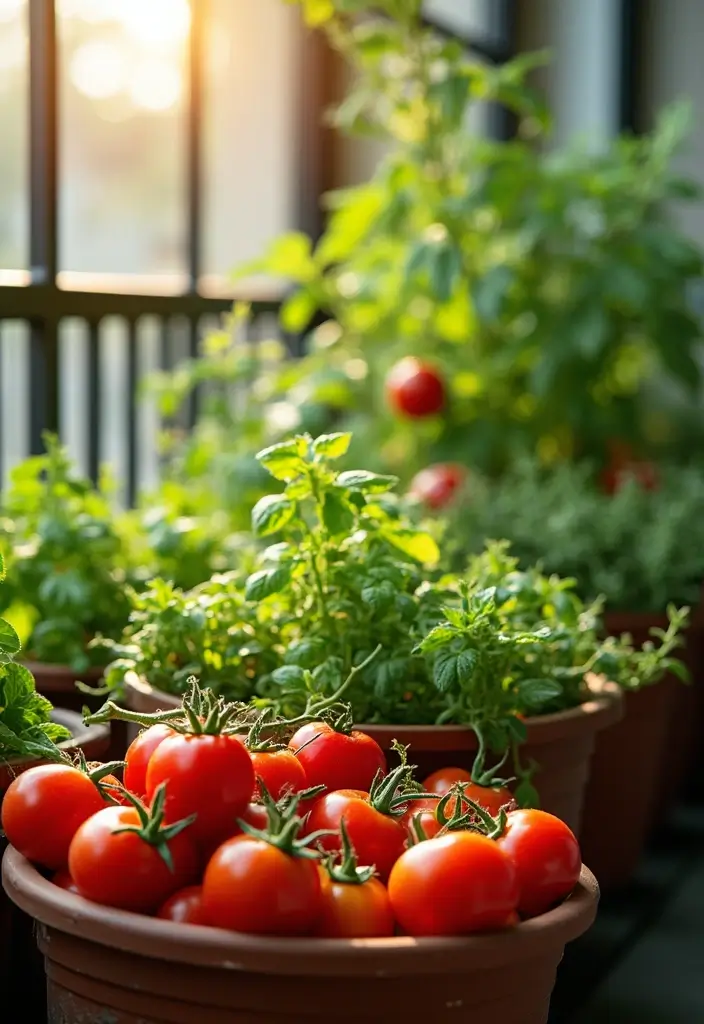
Growing vegetables in containers is an effective way to garden without needing garden beds. With the right containers and a little planning, you can enjoy fresh produce right from your balcony or porch. Here are some strategies to set up a container vegetable garden:
– Choose containers that are deep enough for root vegetables like carrots and potatoes. Consider using self-watering planters that have drainage holes; these can help regulate moisture levels, ensuring your plants thrive.
– Consider the material of your containers; clay and ceramic retain moisture well. Pair these with organic potting soil, specifically designed for container gardening, to provide your vegetables with the nutrients they need.
– Group containers together to create a mini-garden and help plants stay warm. A well-organized setup can enhance the aesthetic and functionality of your space.
– Rotate your crops each season to maintain soil health, and make sure you’re equipped with the right tools. A gardening tool set can simplify your gardening tasks, making it easier to plant, maintain, and harvest your crops.
Container gardening allows you to enjoy bountiful harvests in limited spaces. With these strategies and helpful products, your container vegetable garden can flourish.
5. Raised Bed Gardens
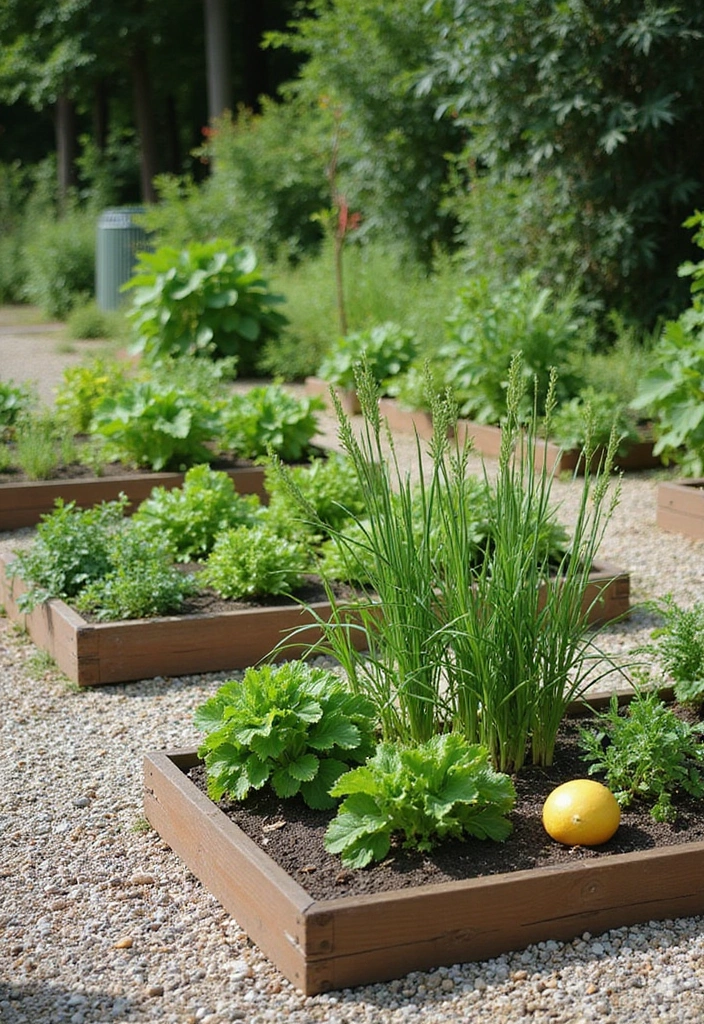
Raised beds can enhance drainage and soil quality, allowing for a fruitful garden even in limited space. Constructed from wood, bricks, or even repurposed materials, raised beds offer a customizable option for your gardening needs.
To create an effective raised bed garden, keep these tips in mind:
– Aim for a height of at least 12 inches to accommodate plant roots. A great option for this is the Raised Garden Bed Kit, which provides sturdy construction for your plants.
– Mix high-quality soil and compost for nutrient-rich planting. Consider using High-Quality Organic Compost to enrich your soil, ensuring your plants thrive.
– Organize plants based on their watering needs to maximize growth potential.
– Use pathways between raised beds to ensure easy access and maintenance. For this purpose, Garden Pathway Gravel can help create a durable and attractive walkway.
Raised beds not only improve your gardening experience but also enhance the aesthetic appeal of your outdoor space with well-organized rows.
6. Vertical Hydroponic System
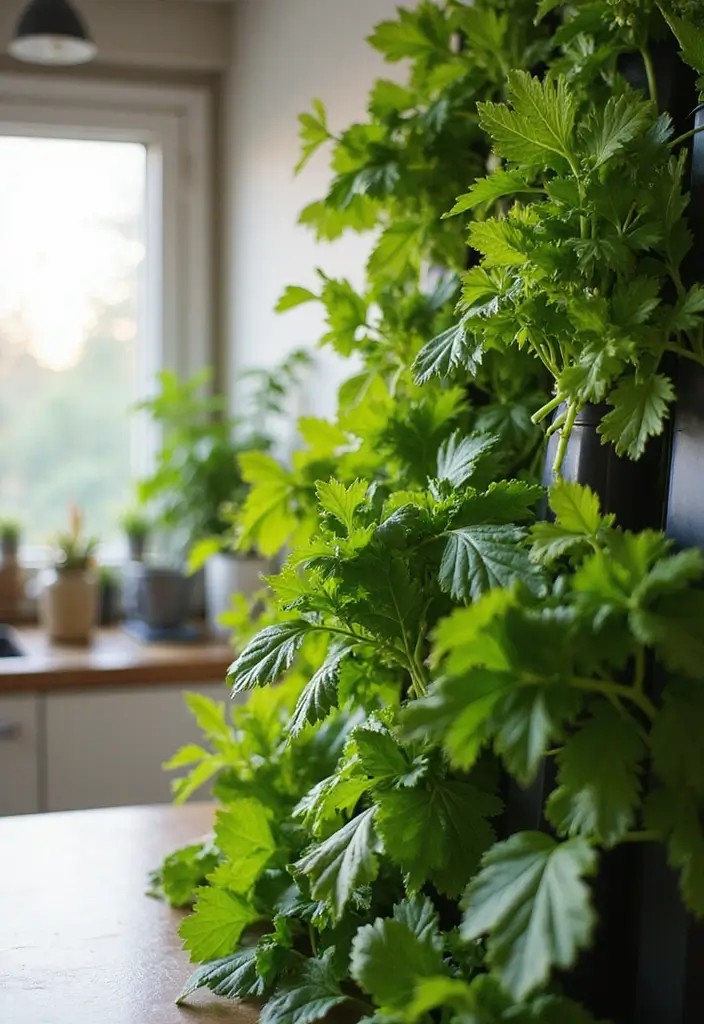
If you’re short on soil but still want to grow herbs and leafy greens, a vertical hydroponic system is an excellent option. This method uses nutrient-rich water instead of soil, allowing you to grow plants more efficiently while taking up minimal space. Here’s how to get started:
– Invest in a pre-made vertical hydroponic kit like the Gardyn Studio Hydroponics Growing System Kit, which includes everything you need, or create your own using PVC pipes.
– Choose fast-growing plants like basil or lettuce for quicker results.
– Monitor water levels and nutrient concentration regularly with a quality nutrient solution such as FoxFarm Grow Big Hydro Organic Liquid Fertilizer, which is designed for hydroponic systems and enhances vegetative growth.
– Ensure adequate lighting, especially if growing indoors, by using an effective light source like the GooingTop LED Grow Light. This grow light provides a full spectrum of light that can be adjusted for dimming and timing, perfect for supporting your indoor plants.
A vertical hydroponic system can yield a surprising amount of produce while looking sleek and modern.
7. Balcony Garden Boxes
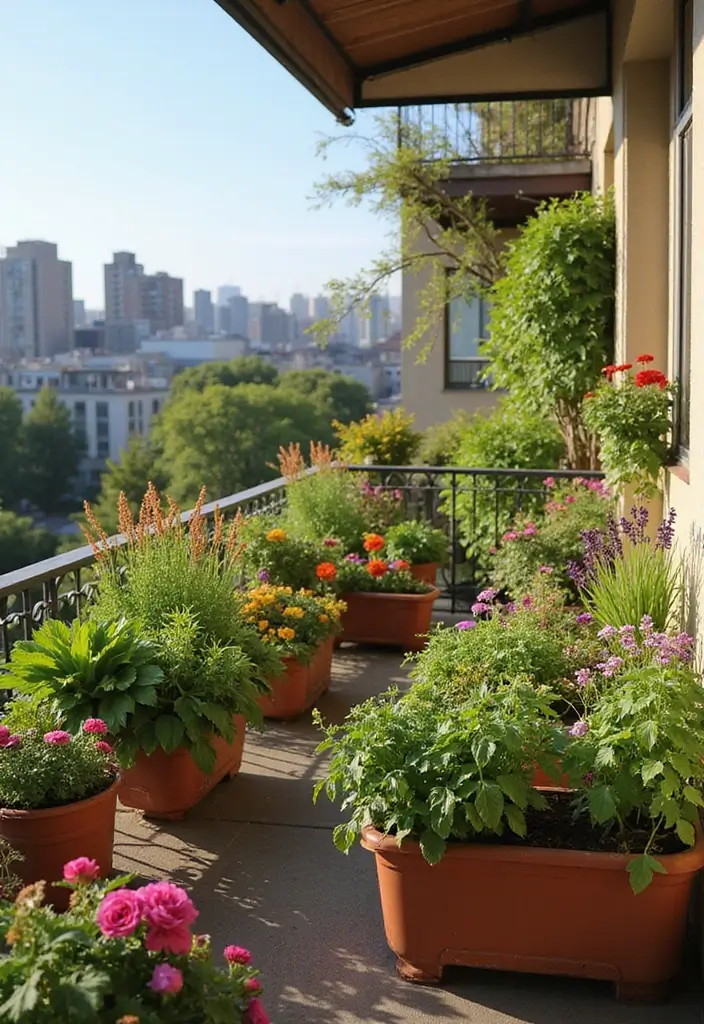
Balcony garden boxes are a practical solution for maximizing small outdoor spaces. These can be lined along railings or positioned on the floor, allowing for a variety of plants without taking up too much room. To enhance your balcony garden, consider using lightweight balcony planter boxes. Made from weatherproof plastic, these boxes are easy to reposition and won’t weigh down your railings.
When selecting plants, choose those that thrive in your climate and sun exposure. To make your gardening experience even more convenient, you might want to invest in a drip irrigation system for container gardens. This adjustable irrigation kit includes everything you need to ensure your plants receive consistent watering without the hassle of manual watering.
Additionally, to create a vibrant and functional setup, consider mixing flowers with herbs for delightful aromas and culinary uses. The herb and flower seed variety pack is a fantastic choice, offering a selection of heirloom, non-GMO seeds that you can grow either indoors or outdoors.
With the right design and these helpful products, your balcony can become a lush retreat filled with color and pleasant aromas.
8. Space-Saving Shelving Units
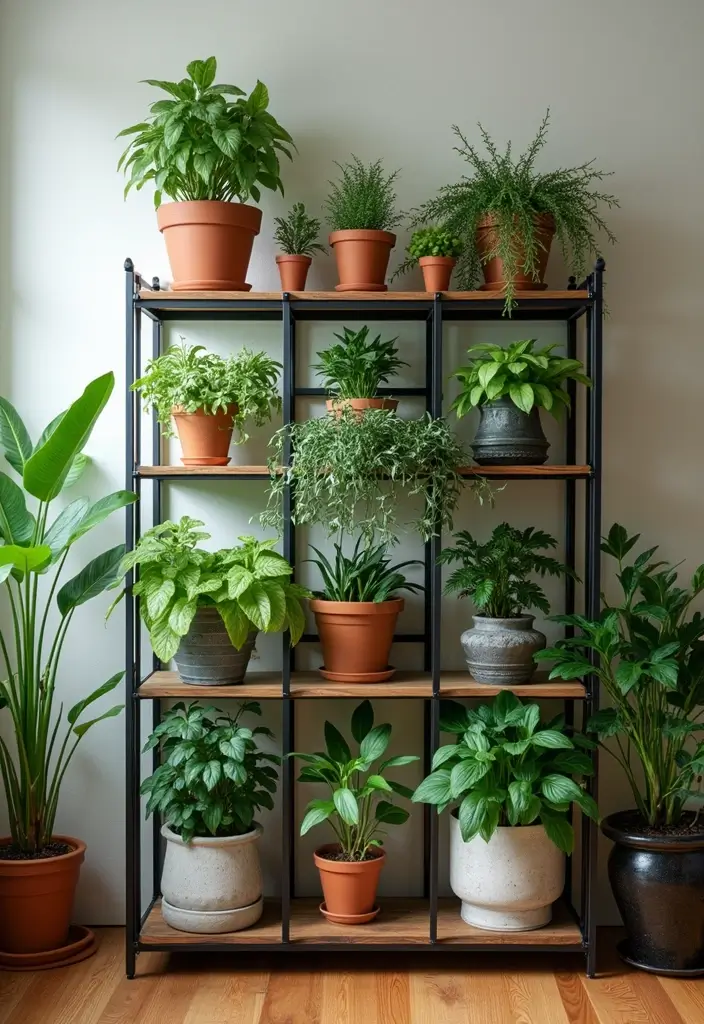
Using shelving units to grow plants can turn any tight space into a flourishing garden. These units can be positioned against walls or in corners, allowing for an organized and aesthetically pleasing display of various plants. To maximize the benefits of your shelving units, consider incorporating products like the vertical garden shelving unit, which is perfect for indoor or outdoor use. Its waterproof metal design makes it suitable for any space, ensuring that your plants are displayed beautifully while also being functional.
To create visual interest, use pots of different sizes. Taller plants should be placed on the top shelves, while shorter ones can go below. To assist with this, consider using the adjustable plant pot set. These risers allow you to elevate your plants at various heights, making it easier to showcase their unique features and ensuring that each plant receives adequate sunlight.
Additionally, shelving units can also double as storage for your gardening tools and supplies. The gardening tool organizer is a heavy-duty solution that helps keep your tools neatly arranged, whether in your garage, shed, or even indoors. This way, you can maintain your shelving’s aesthetic appeal while ensuring that everything you need for gardening is organized and easily accessible.
With the right setup, shelving units not only save space but can also serve as beautiful decor, turning your gardening area into a vibrant showcase.
9. Pallet Garden
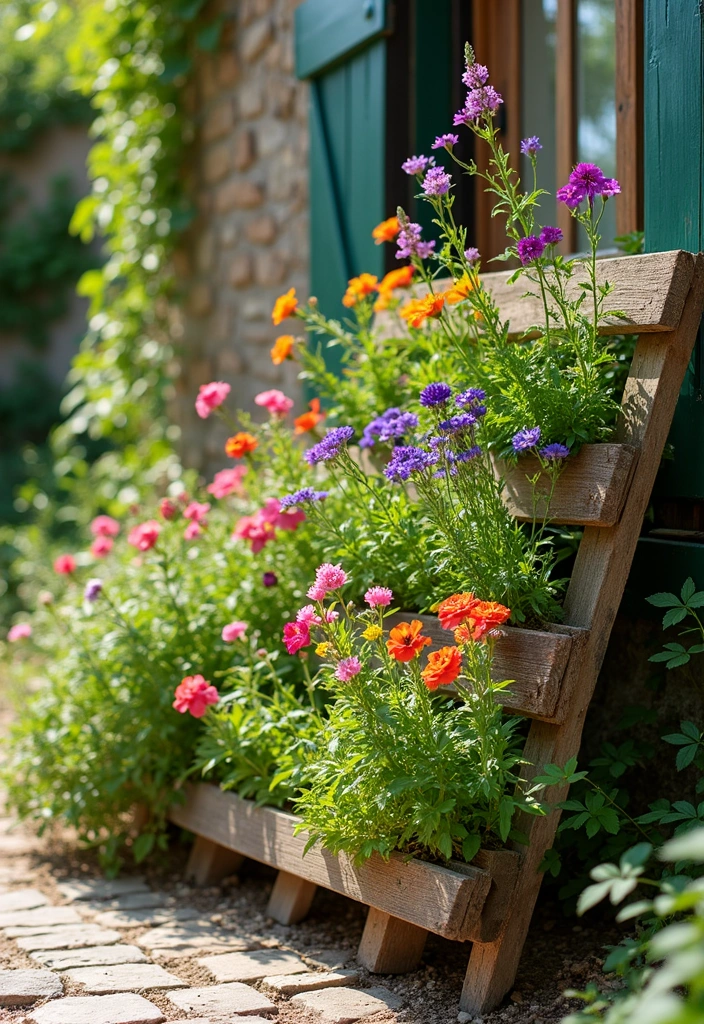
An old wooden pallet can be transformed into a creative and effective garden setup. This method utilizes vertical space effectively and can be an attractive addition to your outdoor area. To create a pallet garden, follow these steps:
– Secure the pallet against a wall for stability.
– Fill each section with soil, and for this, consider using organic potting soil, which is ideal for container gardening and will ensure your plants thrive.
– Choose plants suitable for vertical gardening. Herbs, succulents, and flowers can flourish in pallet setups. An excellent choice for your herb section is the assorted herb seed pack, which offers a variety of culinary herbs perfect for your garden.
– Consider painting the pallet for an added burst of color. If you’re looking for a stylish way to display your plants, the wooden pallet planter can enhance the visual appeal of your setup, while also being functional for outdoor plants.
A pallet garden allows for an eco-friendly approach to gardening while being visually appealing, and these products can help you create a flourishing garden space.
10. Mobile Plant Carts
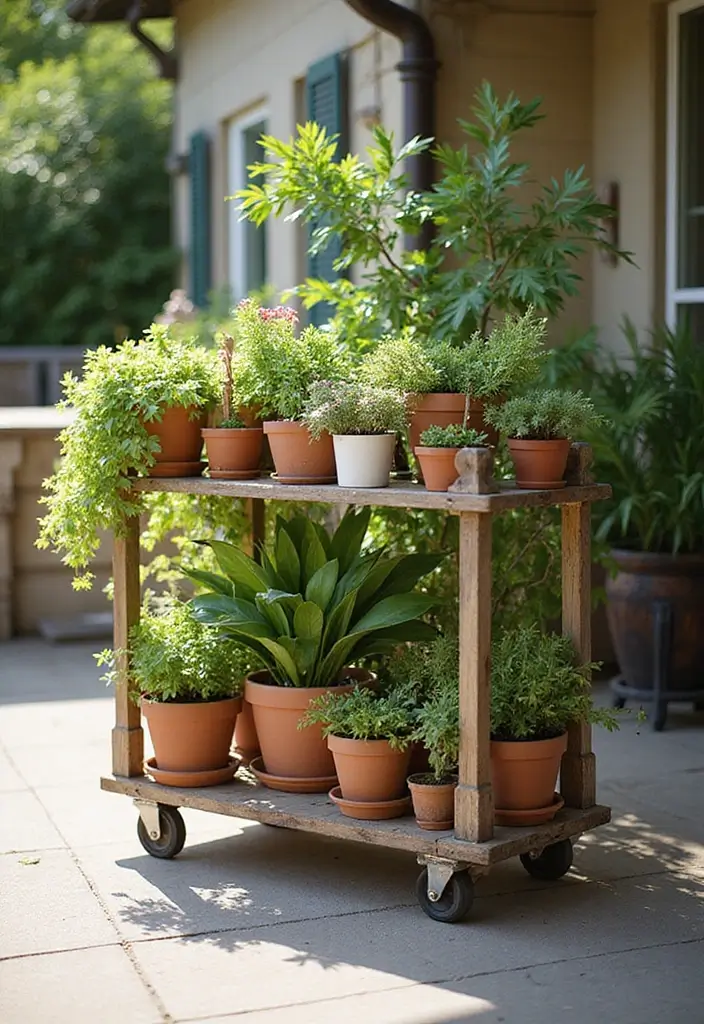
Mobile plant carts are a fun and functional way to create a portable garden that can be easily moved according to sunlight needs. These carts allow for easy access to your plants and can be styled to suit your decor.
To make the most of your mobile plant cart, consider using a sturdy mobile plant cart. This option features wheels that can handle the cart’s weight, providing flexibility in positioning your plants. Additionally, ensure you choose pots with drainage holes, like the pots with drainage holes, to promote healthy plant growth.
Mixing herbs, flowers, and small vegetables on your cart adds variety, enhancing your gardening experience. Finally, position the cart where it gets the most sunlight or can be easily moved as needed. A mobile plant cart adds flexibility to your gardening and enables you to enjoy your plants wherever you want.
11. Greenhouse Tents
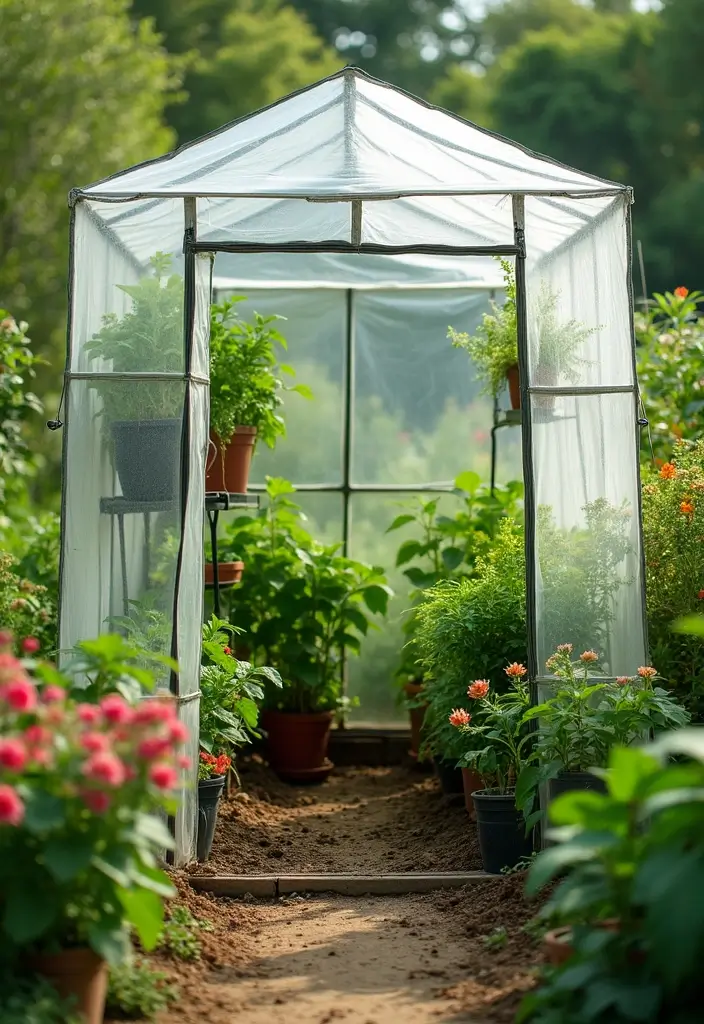
For those serious about gardening, a small greenhouse tent can elevate your gardening game. These tents are perfect for extending your growing seasons and protecting plants from harsh weather. To effectively use a greenhouse tent, consider the following tips:
– Choose a size that fits your space appropriately. A great option is the portable greenhouse tent, which measures 36″x36″x58.5″ and is ideal for small plants and nurseries.
– Ensure proper ventilation and temperature control. Incorporating a greenhouse ventilation fan will help maintain optimal airflow and temperature, making your growing environment more effective.
– Use pots instead of planting directly in the ground to maximize space. The plant pots for greenhouse are perfect for this, offering flexibility for succulents, cuttings, and transplanting.
– Rotate crops to keep the soil healthy. This practice will promote better growth and prevent nutrient depletion.
A greenhouse tent provides a controlled environment, allowing you to grow a diverse range of plants all year round.
12. Herb Spiral Garden
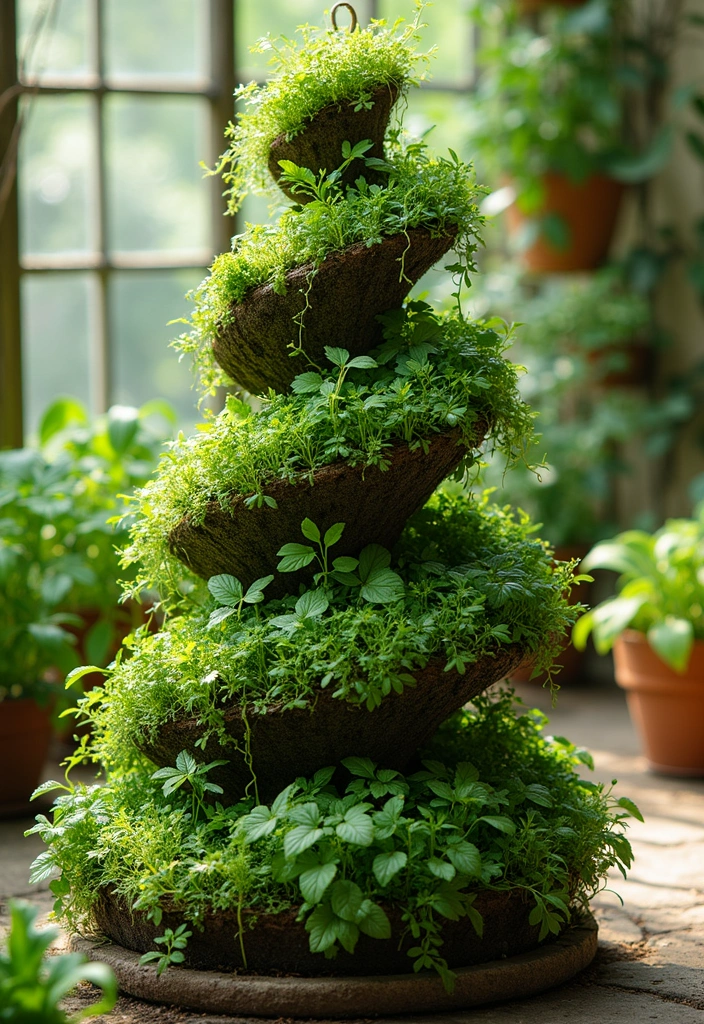
An herb spiral garden is a stunning and resource-efficient way to grow herbs in a small area. This spiraled design allows for various microclimates, letting different herbs thrive in the same compact space. To create one, you can start by using stones or bricks to build your spiral structure. To make planting easier, consider the Garden Spiral Planter, which comes with wheels and a trellis, providing a convenient and mobile option for your herbs.
Plant herbs at different heights to maximize space and efficiency. Incorporating a drip irrigation kit can help maintain moisture in your spiral, ensuring your herbs get the water they need without the hassle of manual watering. This system is perfect for managing water use effectively in a compact garden.
Position the spiral in a sunny spot to promote growth. You can further enhance your herb garden with the organic herb seeds variety pack, which includes a selection of non-GMO, heirloom seeds perfect for your herb spiral. With options like basil, cilantro, and thyme, you’ll have a thriving herb garden that not only serves functional purposes but also adds beauty to your outdoor space.
Herb spirals are not only functional but also serve as a beautiful focal point in your garden. Transform your small space into a thriving herb haven! With an herb spiral garden, you can create microclimates that let your herbs flourish – all while maximizing every inch of your urban oasis.
13. Fairy Garden
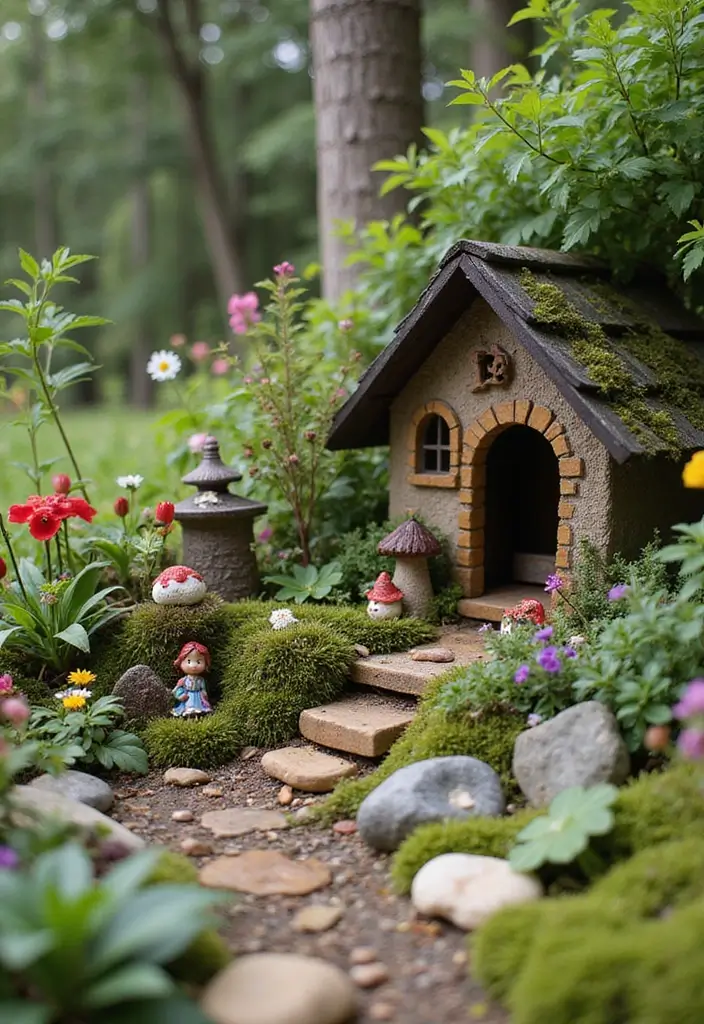
A fairy garden is a whimsical touch to any small space, allowing for creativity and charm. These miniature gardens can be created in containers or in small designated areas, offering an escape into a fantasy world.
To set up your fairy garden, start by choosing small plants that won’t outgrow the space, such as moss, succulents, or miniature flowers. For an assortment of vibrant options, consider the succulent plant assortment, which includes 20 different potted succulents perfect for adding variety and life to your garden.
Next, enhance the magical feel by adding small figurines, fairy houses, and little pathways. A great starting point is the miniature fairy garden accessories set, which comes with 21 pieces including bridges, houses, and decorative ornaments that will bring your fairy garden to life.
Don’t forget to create different sections or themes within your fairy garden. This adds depth and interest to your miniature landscape. To provide a natural look and feel, consider using moss for fairy gardens, which adds a lush green carpet and fits perfectly with the whimsical theme.
Finally, ensure that your garden area gets enough sunlight for the plants to thrive. Fairy gardens not only bring joy and imagination to your gardening experience but also offer a delightful retreat into a fantasy world that you can enjoy every day.
14. Window Box Gardens

Window box gardens allow you to bring greenery to your home without needing an entire garden. These boxes can be attached to windowsills, utilizing vertical space while beautifying your view. Here’s how to maximize your window box:
– Choose herbs and flowers that thrive in direct sunlight. Consider using an herb garden starter kit that includes seeds for a variety of kitchen herbs, perfect for a windowsill garden.
– Ensure good drainage within your box to prevent water buildup. Using a window box planter helps as these planters often come with built-in saucers for effective drainage.
– Use lightweight soil mixes for easy management. A high-quality option like lightweight potting soil mix promotes healthy growth while being easy to handle.
– Regularly prune plants to promote growth and prevent overcrowding.
With a well-planned window box, you can enjoy fresh herbs and flowers right outside your home.
15. Succulent Vertical Gardens
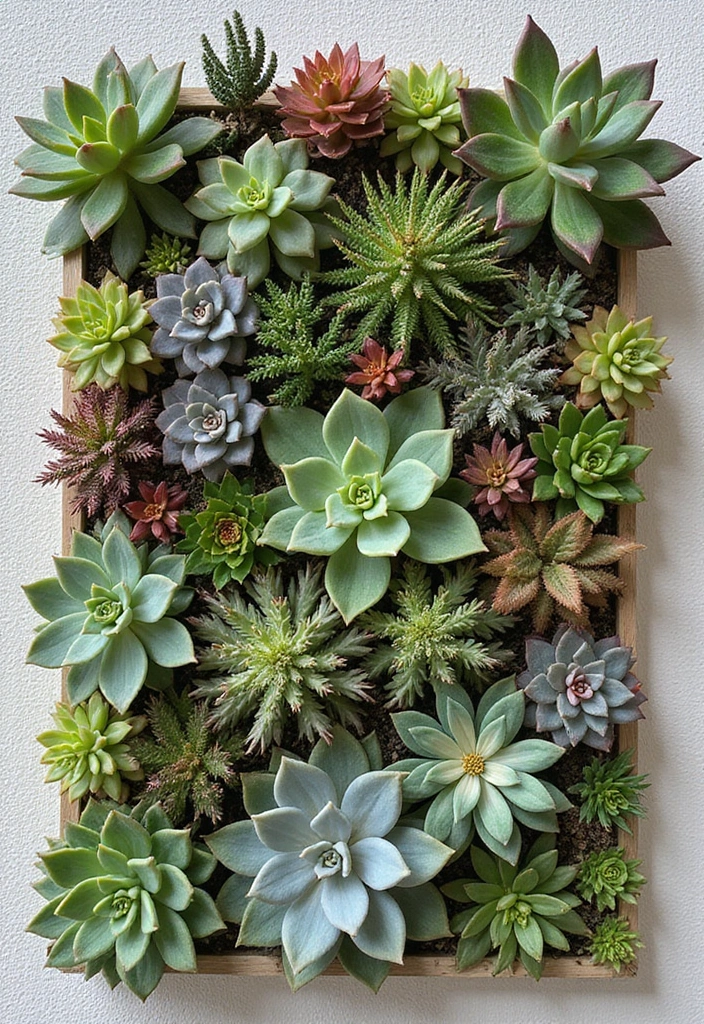
Succulents are perfect for vertical gardens due to their low maintenance and variety of colors. These plants can be arranged in unique patterns on vertical surfaces, creating artful displays while saving space. To get started with your succulent vertical garden, consider using a sturdy frame like the Mr. Stacky 5 Tier Stackable Strawberry, Herb, Flower, and Vegetable Planter, which securely holds your succulents and maximizes your available space.
For visual interest, choose a mix of colors and textures. Using a premium soil like Back to the Roots 100% Organic Succulent & Cacti Mix will ensure your plants receive the nutrition they need to thrive indoors or outdoors.
Additionally, ensure adequate drainage, as succulents do not like to sit in water. The right tools for watering are crucial, and the BEADNOVA Squeeze Bottle Plant Watering Bottle is perfect for providing precise watering without overdoing it.
Position your vertical garden in a sunny area for optimal growth. A succulent vertical garden is not only space-efficient but also adds vibrant character to your home.
16. Recycled Tire Planters
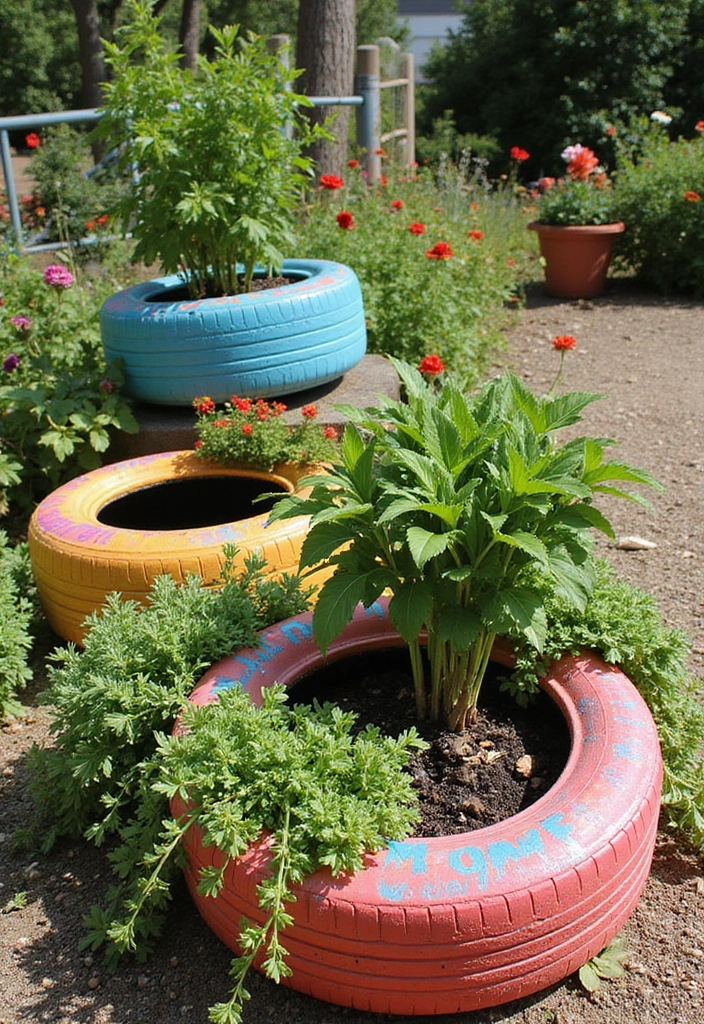
Recycling tires into planters is an eco-friendly way to garden while making a bold statement. These planters can be painted and stacked or arranged creatively to form unique garden features. Here’s what you need to know:
– Clean the tires thoroughly before planting.
– Fill with soil and drainage material to ensure plant health. Using a quality product like Burpee organic potting soil mix is ideal, as it provides the nutrients your plants need, whether for vegetables, flowers, or herbs.
– Ensure proper drainage by incorporating materials such as Legigo leca clay pebbles, which promote healthy root growth and prevent waterlogging.
– Choose colorful paints like Nicpro eco-friendly paint to add a fun and quirky look to your planters.
Layer plants to create a tiered effect. Recycled tire planters add an unexpected twist to your garden and inspire creativity.
17. Mini Greenhouse on a Table
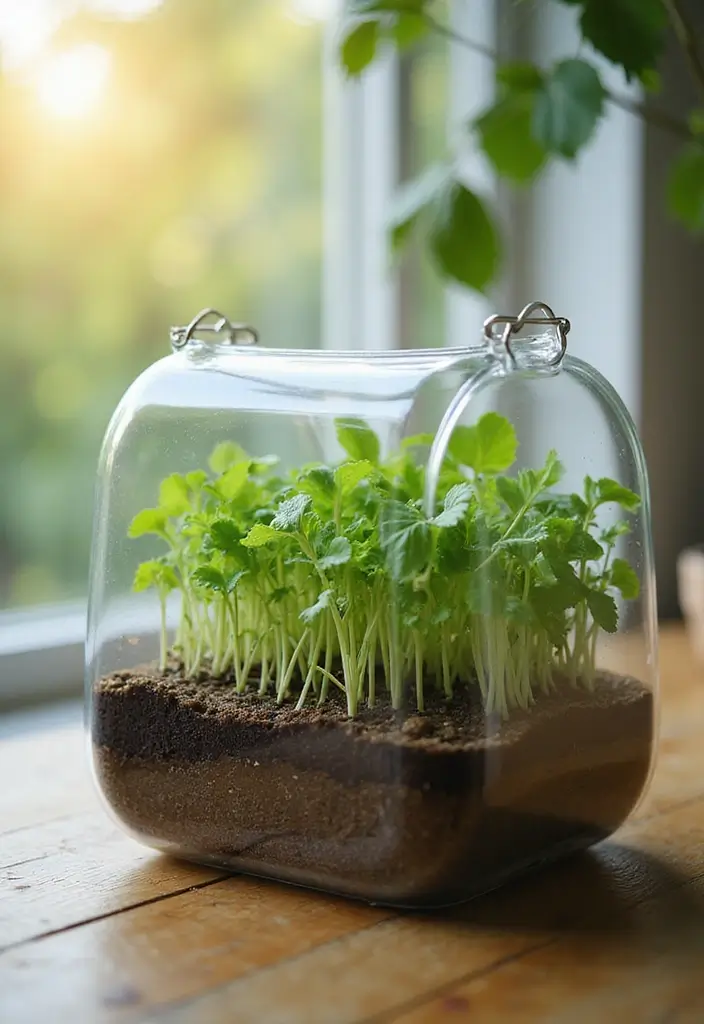
A mini greenhouse can fit right on your table, allowing you to grow plants without taking up excessive space. These mini setups protect plants from pests while providing them with the warmth they need. To set up a mini greenhouse, consider using a clear plastic or glass container to create your greenhouse effect.
For optimal plant growth, choose quick-growing plants like sprouts or microgreens. You can enhance your gardening experience with the Mini Greenhouse Kit, which offers a charming setup that’s perfect for indoor gardening.
It’s important to keep an eye on humidity levels to ensure plant health, and the Humidity Meter for Plants can help you monitor moisture effectively without needing batteries. Lastly, position your mini greenhouse in a sunny spot for optimal growth.
Mini greenhouses offer a unique solution for those eager to start gardening indoors, and with the right tools, like the Seed Starter Trays for starting your vegetable, flower, and herb seeds, you’ll be well on your way to a thriving indoor garden.
18. Community Garden Plot
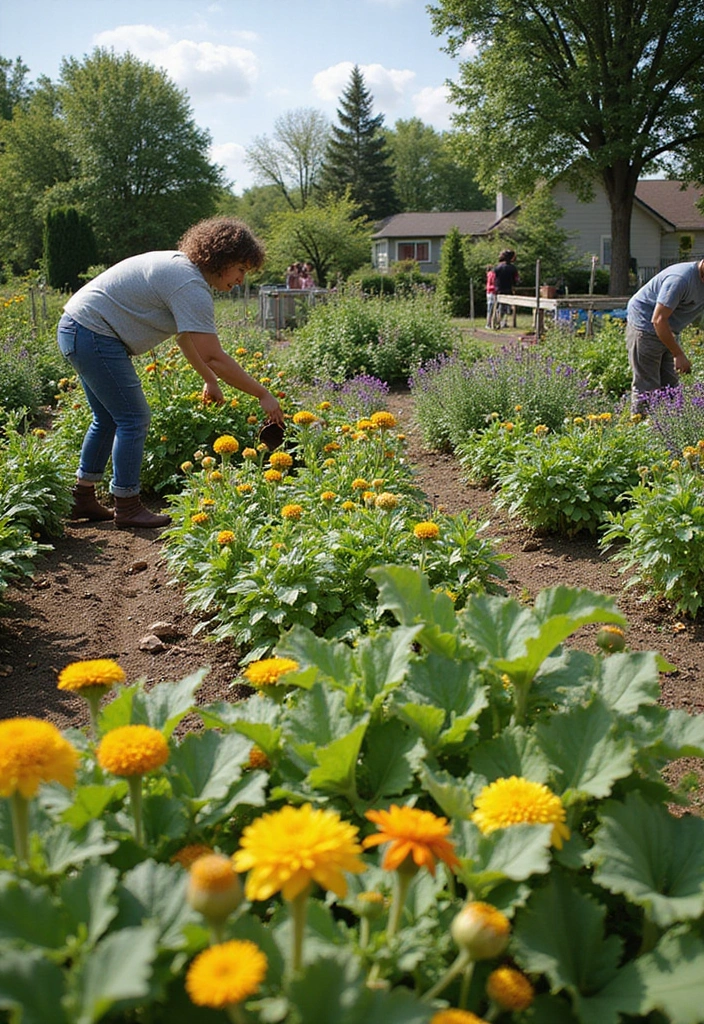
Join or create a community garden plot as a fantastic way to garden without requiring personal space. These shared spaces allow you to grow plants alongside fellow gardening enthusiasts, fostering a sense of community. Here’s how to get involved:
– Research local community gardens and their requirements for membership.
– Collaborate with neighbors to design the layout. Sharing tools and resources, such as a garden tool set, can significantly cut costs and enhance your gardening experience. A comprehensive tool set ensures that you have the right implements for various tasks, making it easier to maintain your plot effectively.
– Consider using a raised garden bed kit for your community plot. These kits are perfect for growing vegetables and can help define your gardening space, making it more organized and accessible for everyone involved.
– Communicate regularly to ensure everyone is on the same page. Don’t forget to invest in a good pair of gardening gloves. Durable gloves will protect your hands while working in the soil and handling plants, allowing you to enjoy your gardening tasks without worry.
Community gardens are a wonderful way to enjoy gardening while making new friends.
19. Square Foot Gardening
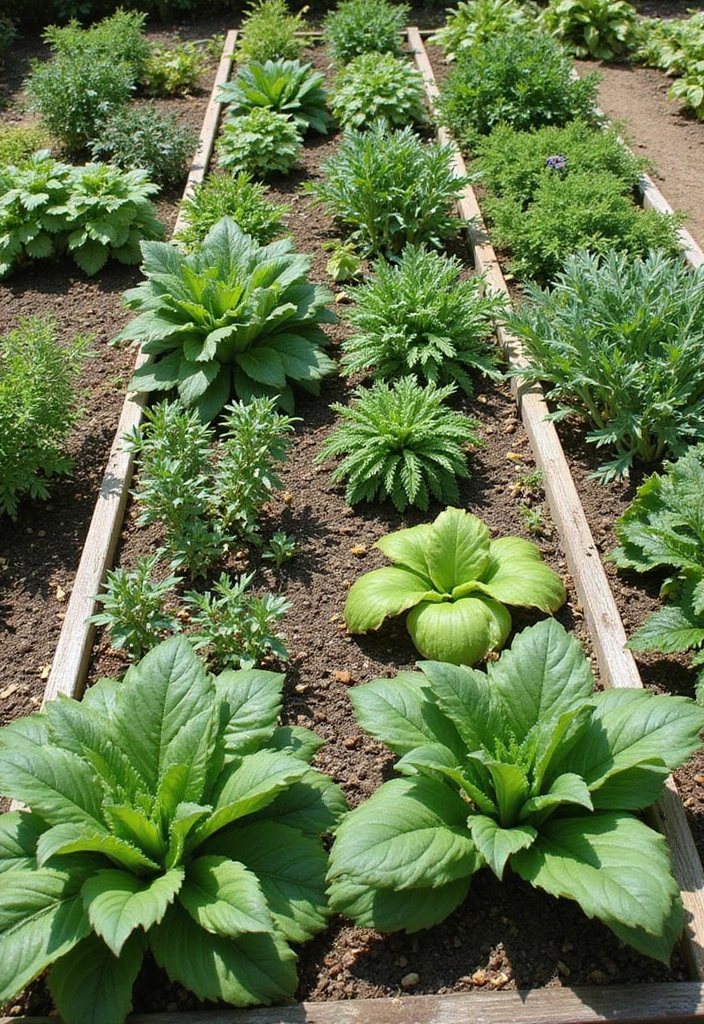
Square foot gardening maximizes space by dividing your planting area into square sections, allowing for efficient planting. This technique can be easily adapted for small plots or raised beds, making it versatile for any space. To practice square foot gardening effectively, consider using a square foot gardening grid. This pre-assembled system waters every plant evenly and can be set up in just two minutes, ensuring your garden layout remains productive and manageable.
Next, it’s important to choose plants that can coexist and thrive in close quarters, which is why a raised garden bed kit can be beneficial. This galvanized planter is ideal for vegetables, providing defined sections that help you implement the square foot gardening method efficiently.
Additionally, keeping track of what you plant in each section is crucial for easy management and crop rotation. A garden journal for plant tracking can help you log your planting details, ensuring you remember which crops are growing where and when to rotate them to prevent nutrient depletion.
Square foot gardening offers a structured approach to gardening in small areas, and with the right tools and planning, you can create a thriving garden in any space.
20. Compact Fruit Trees
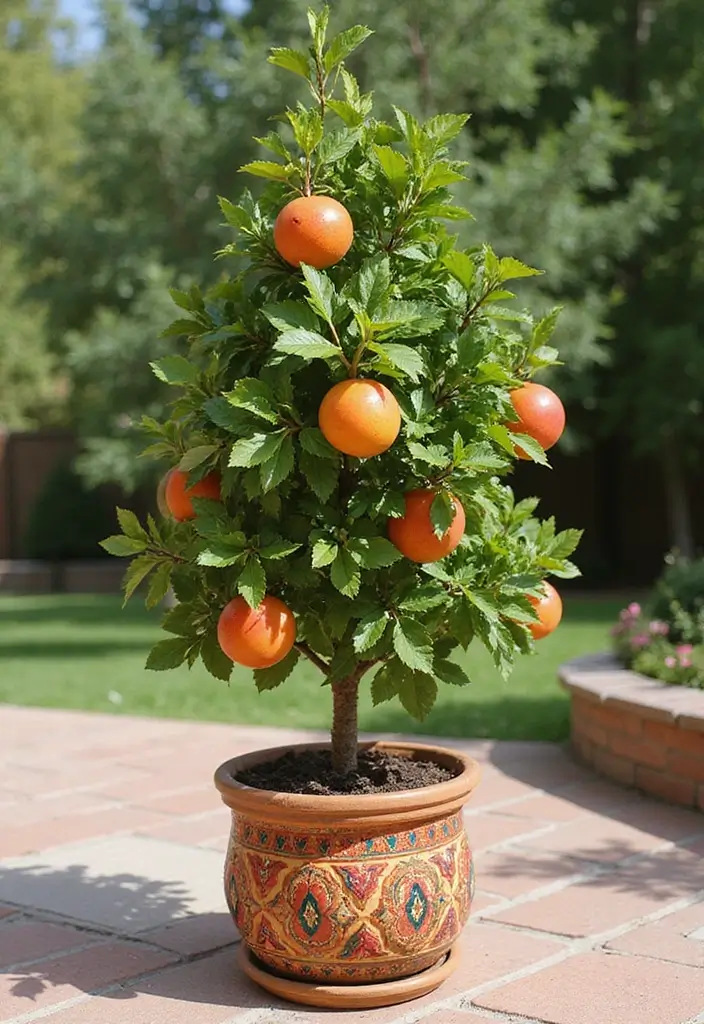
Compact fruit trees are perfect for small gardens or patios, allowing you to enjoy home-grown fruit without needing a large area. These dwarf varieties produce fruit in tight spaces, making them ideal for urban gardening.
To get started, consider using mix dwarf bonsai fruit tree seeds for planting, which includes a variety of options like lemon, cherry, orange, and apple trees. This selection of organic heirloom seeds is tailored for smaller spaces, giving you the chance to cultivate multiple fruit types that thrive in confined areas.
When planting, ensure you have proper containers. Container gardening pots like the Land Guard 4-Pack Fabric Grow Bags are an excellent choice for compact fruit trees. These durable, five-gallon grow bags allow for adequate drainage and can be easily moved to ensure your trees receive optimal sunlight.
Regular pruning is essential to maintain the size of your compact trees and promote fruiting. For this task, a quality tool is necessary, and pruning shears such as Fiskars bypass pruning shears offer a sharp, rust-resistant steel blade that makes trimming effortless.
By incorporating these tips and products, compact fruit trees can bring beauty and bounty to your small space, allowing you to enjoy fresh fruit right at home.
21. Edible Landscaping
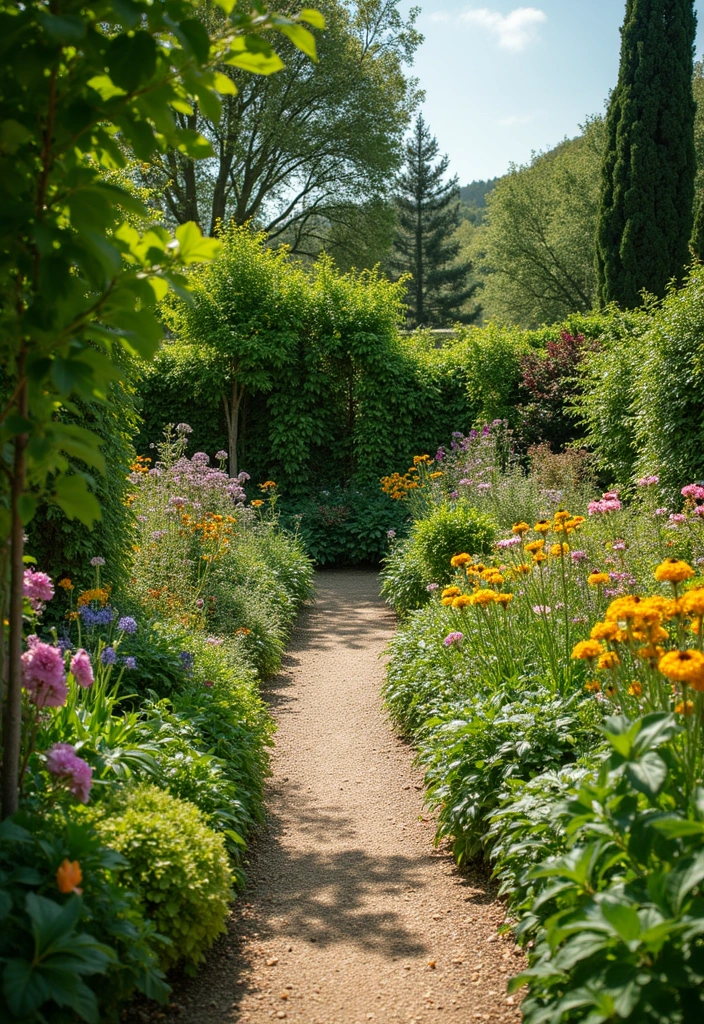
Why not combine beauty and functionality by incorporating edible plants into your landscape? Edible landscaping allows you to grow fruits, vegetables, and herbs alongside ornamental plants, beautifying your space while providing fresh produce.
To get started, consider investing in a raised garden bed kit. This elevated wood planter box is perfect for creating a dedicated space for your edible plants, making maintenance easier and ensuring they thrive. Its sturdy construction can hold up to 300 lbs, giving you plenty of room for a variety of plants.
Additionally, using a herb garden starter kit can help you grow fresh herbs indoors with the aid of an LED grow light. This compact system makes it easy to cultivate your favorite herbs, like rosemary and lavender, right in your kitchen, ensuring you always have fresh ingredients on hand.
Don’t forget about the right tools to help maintain your garden. A quality garden tool set will make your gardening tasks much easier. This 9-piece heavy-duty set includes everything you need to keep your garden looking lush, from planting to harvesting.
By planning out your layout and choosing the right tools, you can ensure your edible landscaping complements both your aesthetic and nutritional needs. Transform your garden into a feast for the eyes and the palate! Edible landscaping not only beautifies your space but also brings the joy of fresh herbs, fruits, and veggies right to your doorstep.
22. Indoor Vegetable Garden
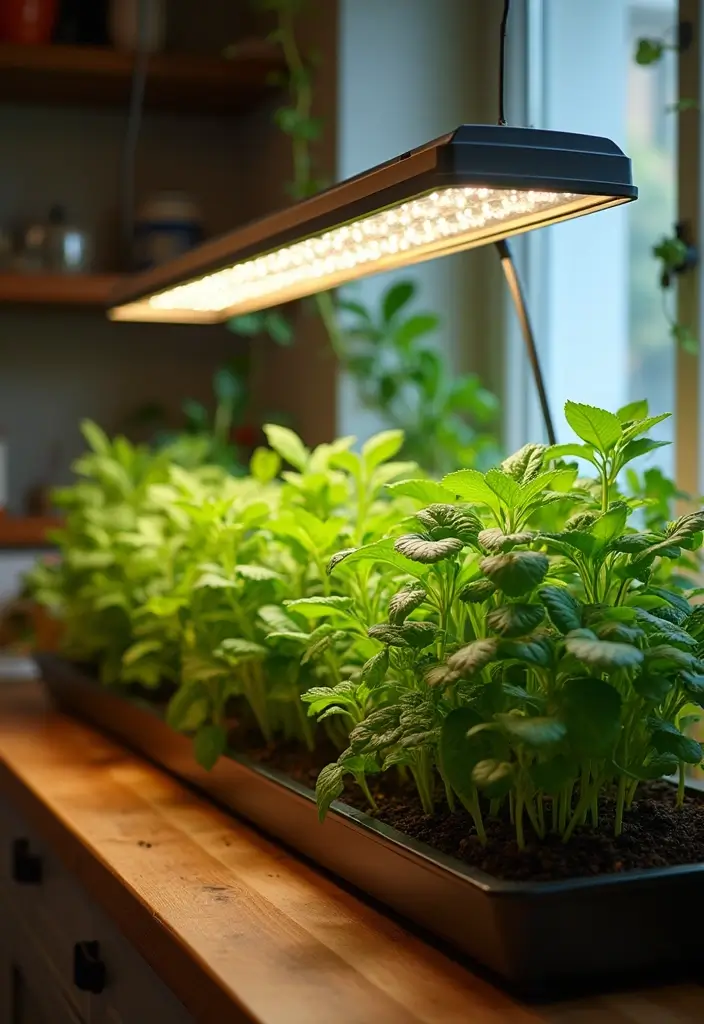
Creating an indoor vegetable garden is a fantastic way to enjoy gardening year-round, regardless of outside conditions. With the right setup, you can cultivate your own fresh produce right in your kitchen or living space.
Start by selecting a well-lit area or, to ensure optimal growth, invest in a quality LED grow light. This product features full spectrum lighting with adjustable brightness levels, allowing you to simulate sunlight for your plants.
Next, choose container sizes that fit your space while accommodating the growth of your vegetables. Consider using plant containers with drainage, which come in various sizes and ensure that your plants have the right environment to thrive. The drainage feature helps prevent overwatering, a common issue for indoor gardens.
Regularly check soil moisture and nutrient levels to maintain plant health. A handy tool for this is the soil moisture meter. This device allows you to monitor the moisture levels without the need for batteries, making it easy to ensure your plants are getting the right amount of water.
Lastly, remember to rotate your plants to promote even growth. An indoor vegetable garden can keep your fresh produce sustainable and accessible, making it a rewarding endeavor all year long.
23. Eco-Friendly Rain Garden
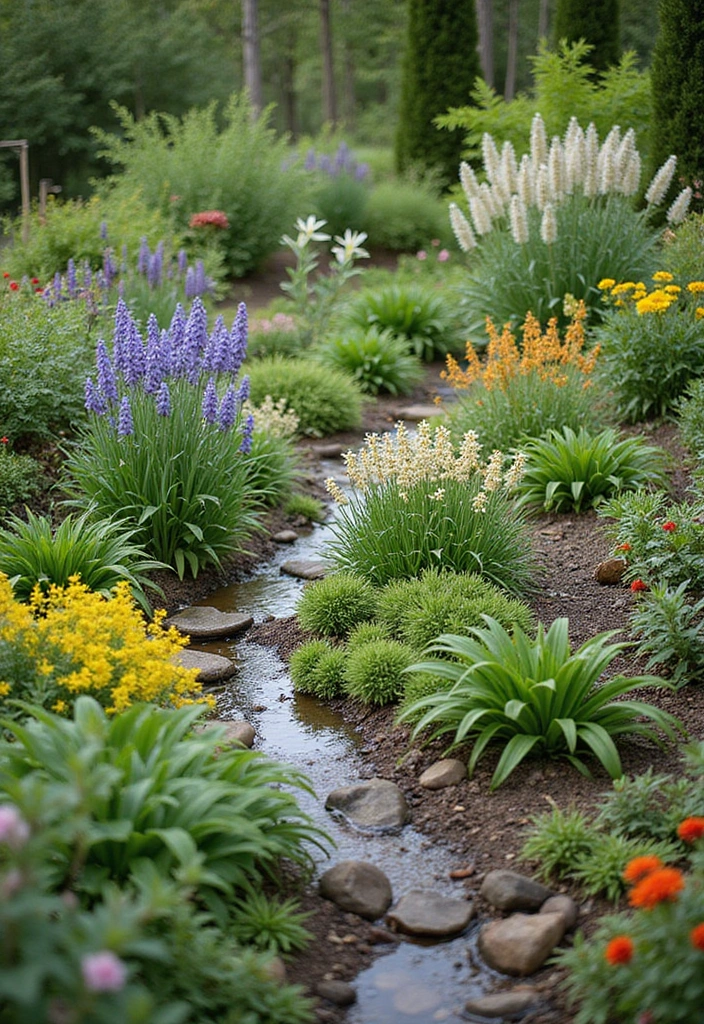
An eco-friendly rain garden is a creative way to manage rainwater while growing beautiful plants. This type of garden collects rainwater runoff, filtering it through various plants that thrive in wet conditions. Here’s how to create a rain garden:
– Choose a low-lying area in your yard for easier water collection. Utilizing a garden drainage solution can help manage excess water effectively, ensuring that your garden drains properly.
– Select native plants that can handle varying moisture levels. Consider using the native plant seed mix, which includes over 7,000 open-pollinated and non-GMO seeds, perfect for your rain garden.
– Ensure proper drainage to avoid oversaturation. Incorporating rain garden soil amendments like Farmer’s Secret Soil Revitalizer can enhance the health of your soil, promoting better water absorption and plant growth.
– Design your garden with varied plant heights for visual appeal.
A rain garden not only beautifies your space but also promotes water conservation. With the right plants and drainage solutions in place, you can create a lush and eco-friendly environment that supports local wildlife and enhances your landscape.
24. Themed Pot Collection
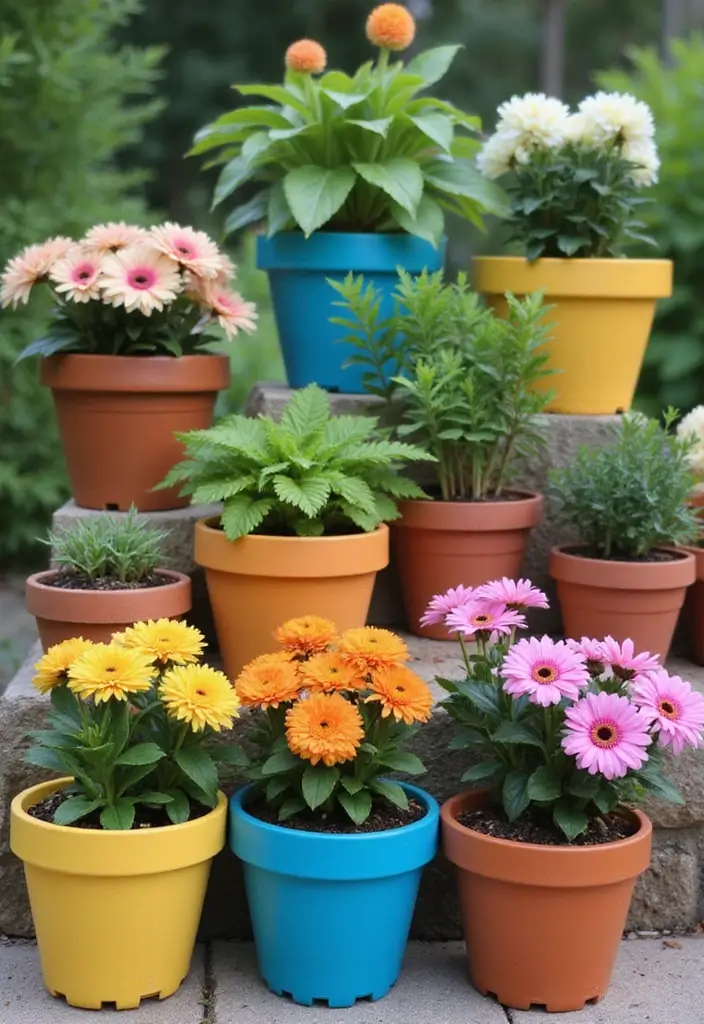
Creating a themed pot collection can transform a simple garden into a cohesive design statement. By grouping pots based on color, material, or plant type, you create a visually pleasing space that showcases your personal style. To enhance your themed pot collection, consider incorporating some carefully chosen products that not only support your design vision but also help you maintain your garden effectively.
Start by selecting a common theme, such as pastel colors or terracotta pots. For a charming touch, the pastel colored plant pots are an excellent choice. Their unique and vibrant designs can beautifully complement a variety of plants while giving your garden an eclectic yet coordinated look.
Next, vary pot sizes and heights to create dimension. The terracotta pot set offers a beautiful range of sizes, allowing you to arrange your plants in an eye-catching manner. These classic pots not only provide drainage for your plants but also add a rustic charm to your themed collection.
Choosing plants that visually complement your pot theme is crucial for a harmonious design. To keep your plants thriving, regular maintenance is key. Consider using the plant care kit, which includes a variety of essential tools to help you tend to your indoor and outdoor plants efficiently. With these tools, you’ll ensure that your themed pot collection remains tidy and vibrant.
A themed pot collection can elevate your gardening game while keeping it fun and fresh. Embrace the creativity of gardening with the right tools and pots that reflect your style!
25. Zen Garden
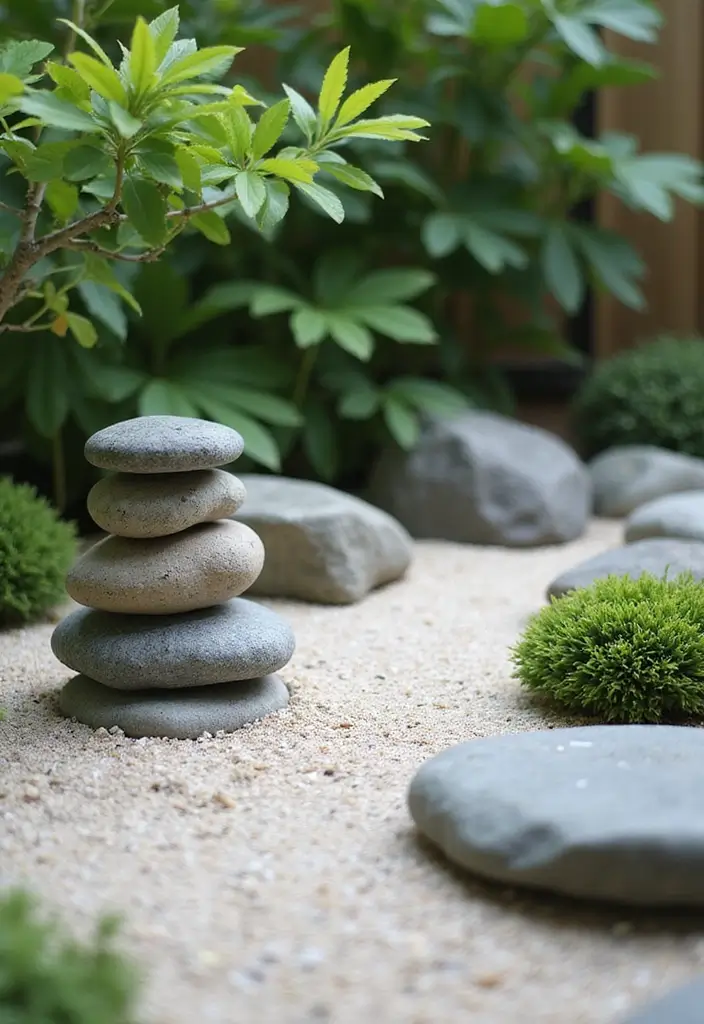
Creating a Zen garden offers a serene escape while incorporating plants into a peaceful design. These gardens typically focus on minimalism and harmony and can be adapted for any small space. To create a Zen garden, begin by using sand, gravel, or stones to represent water and create pathways. For this, consider using decorative gravel for zen gardens, which includes natural polished stones that will add a calming aesthetic to your garden’s layout.
Select plants that embody tranquility, like bamboo or moss. The bamboo plant starter kit is a wonderful choice, bringing good luck and prosperity while being easy to care for—perfect for a mindful gardening experience.
Design the layout thoughtfully to encourage mindfulness. Regularly raking the gravel or sand is essential to maintain the desired look, and using a zen garden rake will make this task easier. This large Japanese rake is designed for effective grooming of your Zen space.
A Zen garden promotes relaxation and mindfulness, making it a perfect retreat. Embrace minimalism, and let tranquility guide your garden layout!
26. Gutter Garden
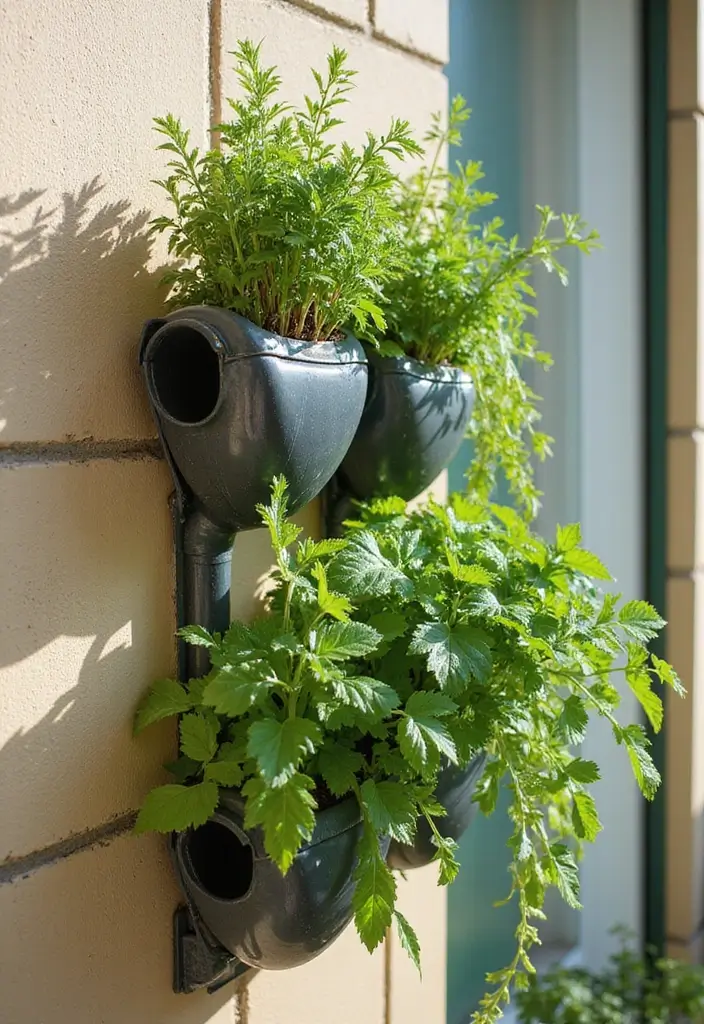
Repurposing old gutters into vertical garden planters is an innovative way to create a unique garden layout. These gutter gardens can be mounted on walls, making them an ideal choice for limited spaces. Here’s how to set up a gutter garden:
– Secure gutters at an angle to allow for proper drainage.
– Fill with soil such as Miracle-Gro potting mix, which is perfect for container plants and will help your herbs or succulents thrive.
– Consider using a variety of herbs for culinary use. A great start is with the herb garden seed kit, which includes 15 different non-GMO heirloom seeds to start your indoor or outdoor garden.
– Position them where they can receive ample sunlight.
– For added vertical space, you might also explore the Vertical Garden Planter, which allows for additional planting options whether it’s strawberries, herbs, or flowers.
Gutter gardens not only save space but also add an interesting visual element to your home. With the right soil, seeds, and planters, you can create a flourishing garden in even the tightest of spaces.
27. Plant Wall Art
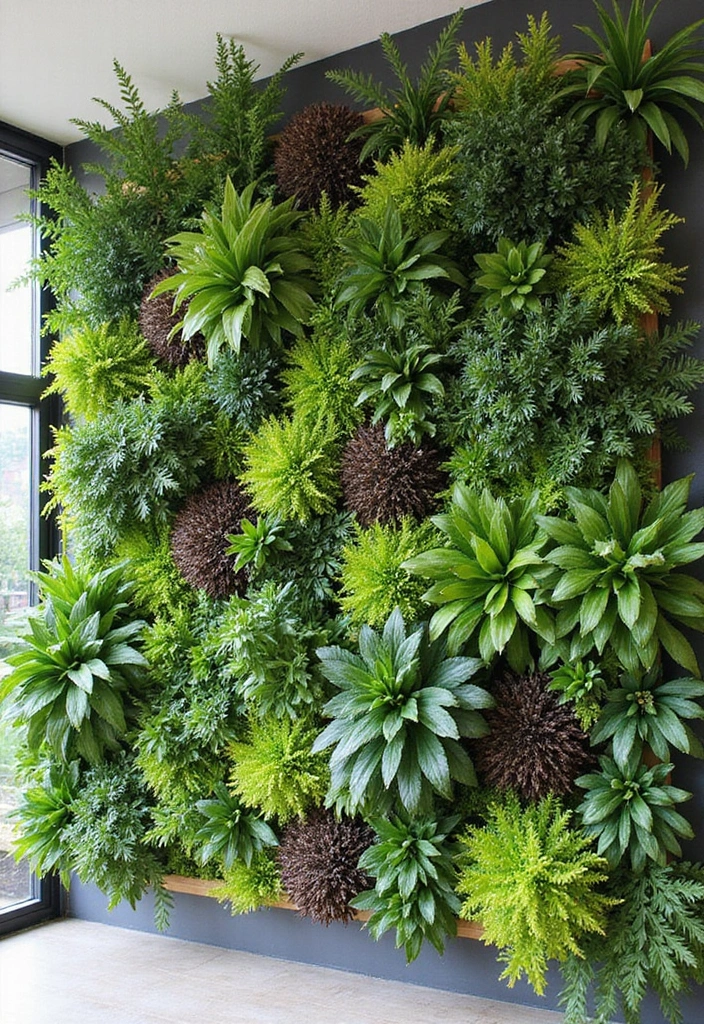
Turn your garden into a living piece of art with a plant wall.
This design uses various plants to create patterns or shapes, allowing you to express your creativity. To create a plant wall, start by selecting a suitable wall that receives enough sunlight. If you’re looking for a way to maximize your gardening space, consider using a 5 tier vertical raised garden bed planter box. This vertical planter not only provides ample space for your herbs, flowers, and vegetables, but its drainage holes ensure your plants thrive both indoors and outdoors.
Next, enhance your design with a sturdy support structure. An adorox garden arch trellis is perfect for climbing plants and can serve as an elegant frame for your plant wall art. Its metal construction offers stability, making it ideal for various decorative settings, from a casual backyard to a festive event.
For added interest, opt for plants with different textures and colors. A set like the easy to grow houseplants (12 pack) provides a delightful variety of indoor and outdoor plants that come in their own containers. This makes it easy to integrate them into your wall art design without the hassle of repotting.
Plan the layout carefully to make it visually balanced. With the right products and some creativity, your plant wall installation can become a stunning focal point while maximizing your gardening space.
28. Vertical Strawberry Planter
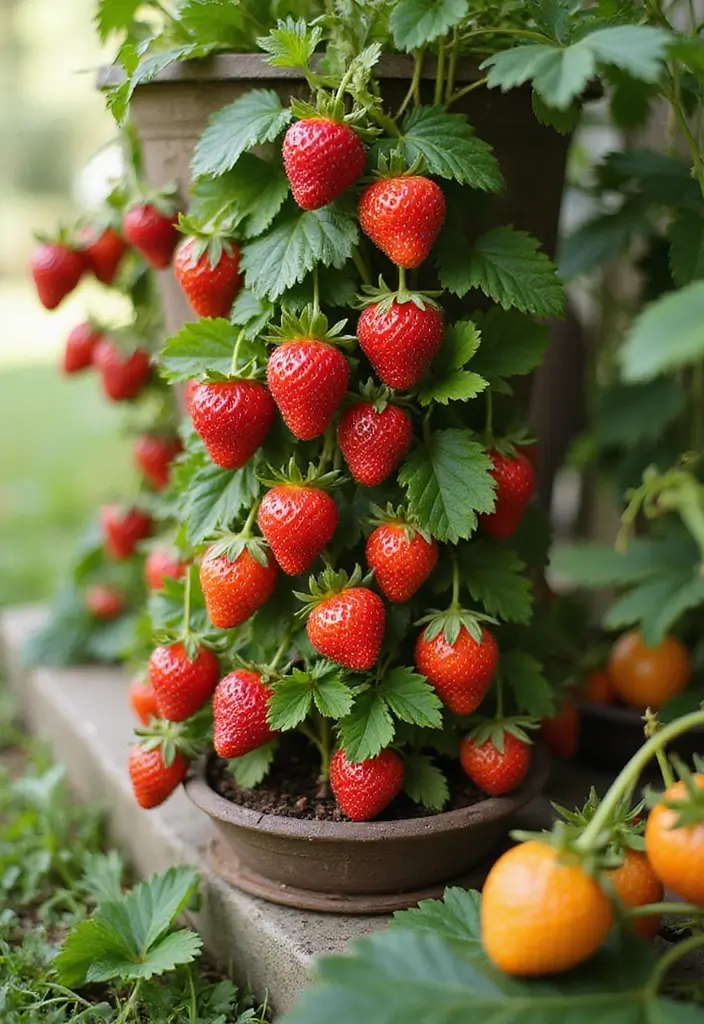
Growing strawberries vertically allows you to enjoy this sweet fruit even in small spaces.
By giving strawberries the vertical treatment, you not only save space but also create an attractive display. To set up your vertical strawberry planter, consider using stackable planters like the Mr. Stacky 5 Tier Stackable Strawberry, Herb, Flower, and Vegetable Planter. These planters are designed to maximize your space while keeping your strawberries easily accessible.
Ensure good drainage for healthy growth; the design of stackable planters helps with this by allowing excess water to flow through each tier. For a more advanced option, look at the Vertical Garden System from Greenstalk. This system features a patented internal watering mechanism, making it easier to maintain moisture levels for your strawberries and other plants.
Additionally, consider companion planting with flowers to attract pollinators and enhance your garden’s aesthetics. A great option is the companion planting seeds variety pack, which includes a mix of beautiful flowers like zinnias and marigolds. These flowers will not only attract beneficial insects but also create a vibrant display alongside your strawberries.
A vertical strawberry planter is a delightful addition to any small garden, bringing joy and fresh fruit while utilizing your space effectively.
29. Succulent Wreath
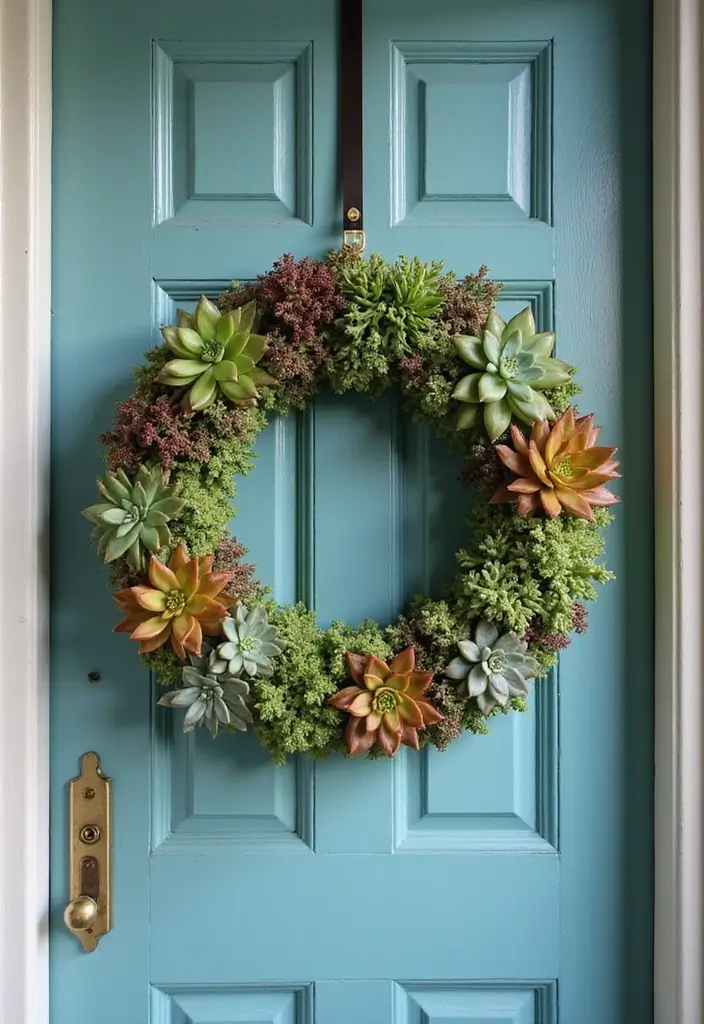
Creating a succulent wreath allows you to bring a touch of green to your door while saving space. These living decorations are low-maintenance and can last for years with proper care. Here’s how to make a succulent wreath:
– Start with a wire wreath frame to form the base of your wreath. This 14-inch dark green metal frame is perfect for holding everything together.
– Fill the frame with moss and potting mix, like the premium sphagnum moss. This provides a natural growing medium for your succulents.
– Attach your chosen succulent plants assortment securely to the wreath. This bulk collection includes a variety of live mini succulents, allowing you to create a unique and colorful display.
– Water sparingly and place the wreath in an area with indirect light.
– Regularly check for any dead leaves or overgrowth to keep your wreath looking its best.
A succulent wreath is a beautiful way to combine gardening with home decor, and these products will help you create a thriving piece of living art.
30. DIY Plant Stand
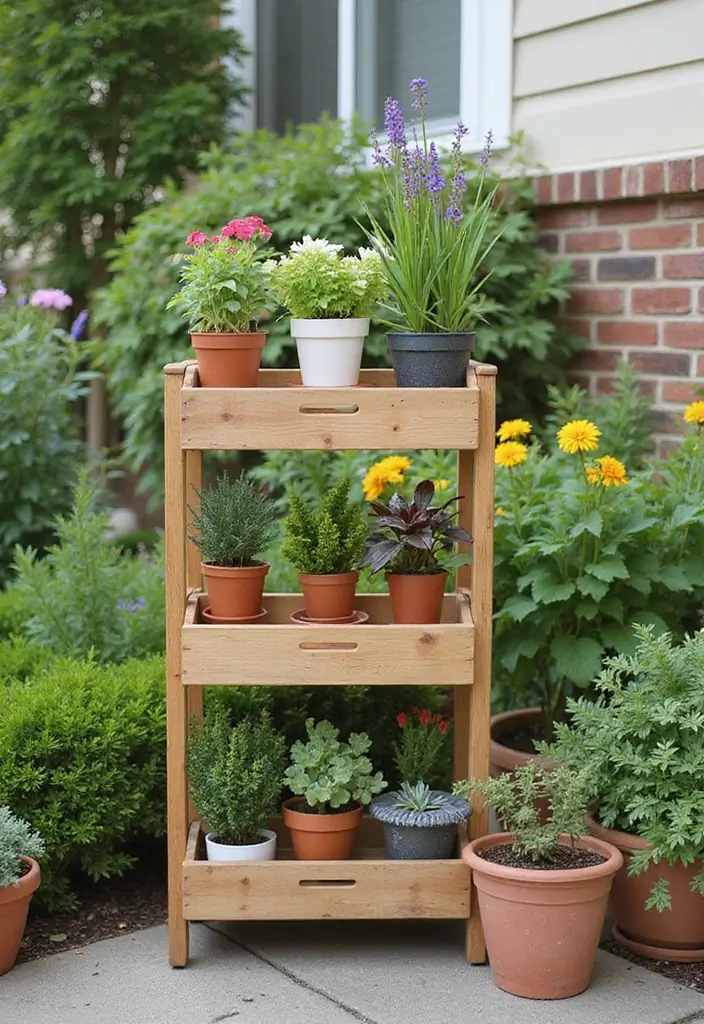
A DIY plant stand can elevate your plants while adding a personal touch to your decor. These stands can be made from a variety of materials, allowing for creativity and customization. Here’s how to create your own:
– Gather materials like wood or metal, depending on your style. If you choose wood, consider using a woodworking tool set which includes all the essential tools for shaping and carving your stand. It’s perfect for beginners and ensures you have everything you need to get started.
– Design a stand that fits your space and the size of your plants. For a more durable option, consider a metal plant stand. These heavy-duty stands are anti-rust and can hold multiple pots, making them an excellent choice for both indoor and outdoor settings.
– Incorporate different levels for an appealing look, which not only showcases your plants beautifully but also adds an artistic flair to your garden space.
– Finally, treat the materials to ensure longevity outdoors. Using a product like outdoor wood sealant will protect your wooden structures from moisture and extend their life, ensuring they remain a beautiful part of your garden for years to come.
With these suggestions, you can create a plant stand that enhances your gardening experience and complements your home decor beautifully.
Conclusion: Your Garden Awaits
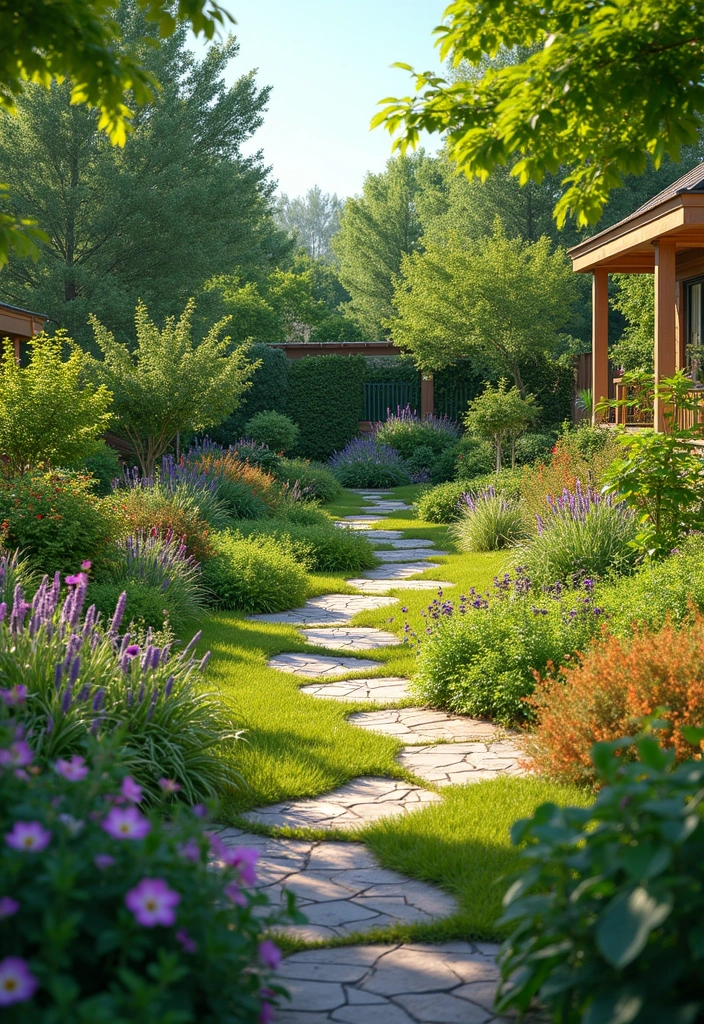
With these 30 grow-a-garden layout plans, your small space can become a thriving garden!
Each idea offers unique ways to create beauty while being functional, whether you’re growing vegetables, herbs, or flowers. Remember to experiment and let your creativity flow as you design your garden. Happy gardening!
Note: We aim to provide accurate product links, but some may occasionally expire or become unavailable. If this happens, please search directly on Amazon for the product or a suitable alternative.
This post contains Amazon affiliate links, meaning I may earn a small commission if you purchase through my links, at no extra cost to you.
Frequently Asked Questions
What are the best garden layout ideas for small urban spaces?
Creating a beautiful garden in a small urban space is all about making the most of what you have! Consider using vertical gardening techniques, such as installing a vertical wall garden or using hanging baskets. These methods not only save space but also add a stunning aesthetic to your environment. Additionally, raised bed gardens and container gardening can help you grow a variety of plants without taking up valuable ground space.
How do I choose the right containers for my vegetable garden?
Choosing the right containers for your vegetable garden is crucial for ensuring healthy plant growth. Opt for containers with drainage holes to prevent waterlogging. Consider the size of the container based on the type of vegetable you plan to grow; deeper pots are great for root vegetables, while shallower ones work well for herbs and leafy greens. Don’t forget to use high-quality potting soil to provide your plants with the nutrients they need!
Can I grow vegetables indoors, and if so, how?
Absolutely! You can create an indoor vegetable garden with a few simple steps. Start by choosing suitable containers and a sunny spot near a window or use grow lights if natural light is limited. Select compact veggies like lettuce, herbs, and radishes that thrive in smaller spaces. Make sure to keep the soil moist but not soggy, and watch your little garden flourish all year round!
What are some eco-friendly options for small space gardening?
Embracing eco-friendly gardening practices in small spaces is not only possible but rewarding! Consider creating a rain garden to manage rainwater runoff and support local wildlife. You can also use recycled materials for planters, like old tires or wooden pallets. Additionally, incorporating native plants can help reduce water usage and attract beneficial pollinators to your mini garden!
How can I make my vertical garden more aesthetically pleasing?
Making your vertical garden visually appealing is all about creativity! Use a variety of plants with different colors, textures, and heights to create a dynamic look. Incorporate decorative elements like trellises or artfully arranged containers to add interest. You might even try themed plant collections or seasonal displays to keep your vertical garden fresh and exciting throughout the year!
Related Topics

